The operating hours of the establishment are from 10:00 AM to 9:00 PM. The cafe is closed on Tuesdays. The “Retro Cafe” is open from 10:00 AM to 8:00 PM on the days of the Planetarium.
Contact us at +7 (495) 221-76-90. Planetarium JSC © 2017. Located at 5 Sadovaya-Kudrinskaya St., Building 1 in Moscow.
Jupiter’s Opposition to the Sun
On August 20, 2021 at 03:20 Moscow time, Jupiter will reach the point of opposition with the Sun. The planet’s brightness will be at its peak, reaching a magnitude of nearly minus 3 (-2.9m) in August. This makes Jupiter the third most luminous object in the night sky, following only the Moon and Venus. Moreover, the distance between Earth and Jupiter will be the closest it has been all year, presenting a unique opportunity to observe the planet in exquisite detail!
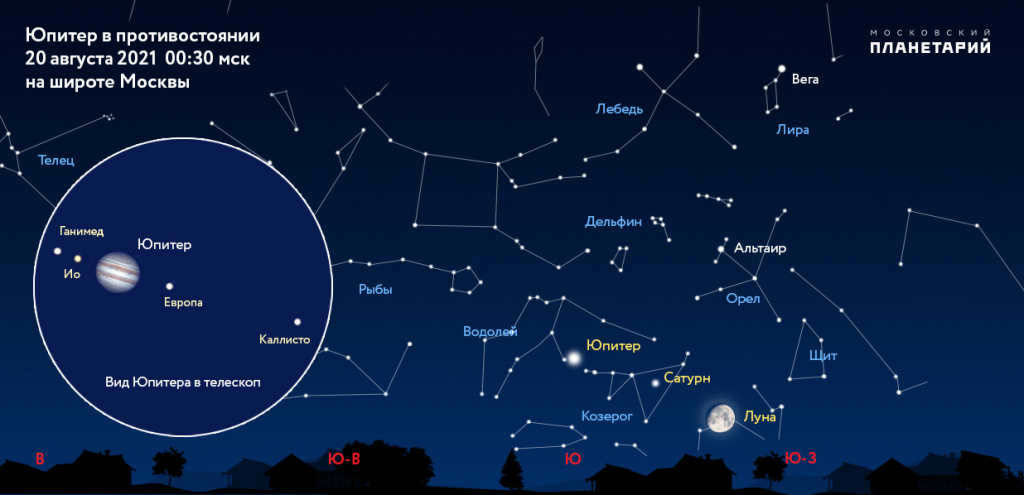

Summer and autumn 2021 provide excellent opportunities for observing Jupiter and Saturn! Throughout the summer season, Jupiter can be seen shining brightly in the southern sky and remains visible all night long when the weather is clear. Positioned to the right (south) of Jupiter, Saturn is also easily visible, having already passed the opposition point on August 2, 2021.
- The alignment of celestial bodies where their centers fall on the same straight line, with Earth positioned between the Sun and the planet, is referred to as planetary opposition.
- Opposition moments offer prime conditions for observing outer planets (from Mars to Neptune) and asteroids, as the planet is at its closest distance to Earth and fully illuminated by the Sun during this time.
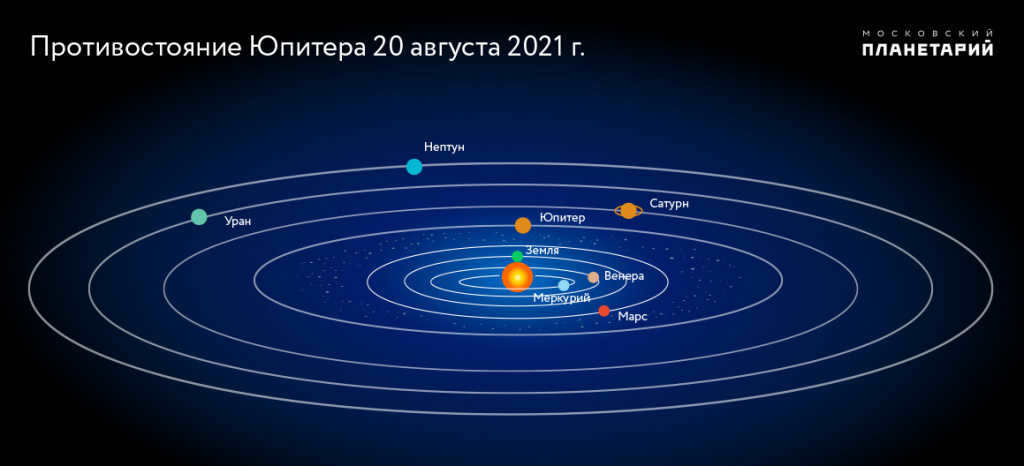
- During opposition, Jupiter is at its closest distance to Earth and appears the brightest. It reaches the celestial meridian at midnight, giving it the maximum duration of nighttime visibility. Additionally, Jupiter’s angular size in the sky is the largest it will be all year.
Observation of Jupiter:
Therefore, August and September present optimal circumstances for observing the colossal celestial bodies, Jupiter and Saturn, as they reach opposition: Saturn on August 2nd and Jupiter on August 20th. The planets are in close proximity to each other and during the month of August, they are easily visible starting from the late afternoon and continuing throughout the night, reaching their highest point above the southern horizon shortly after midnight.
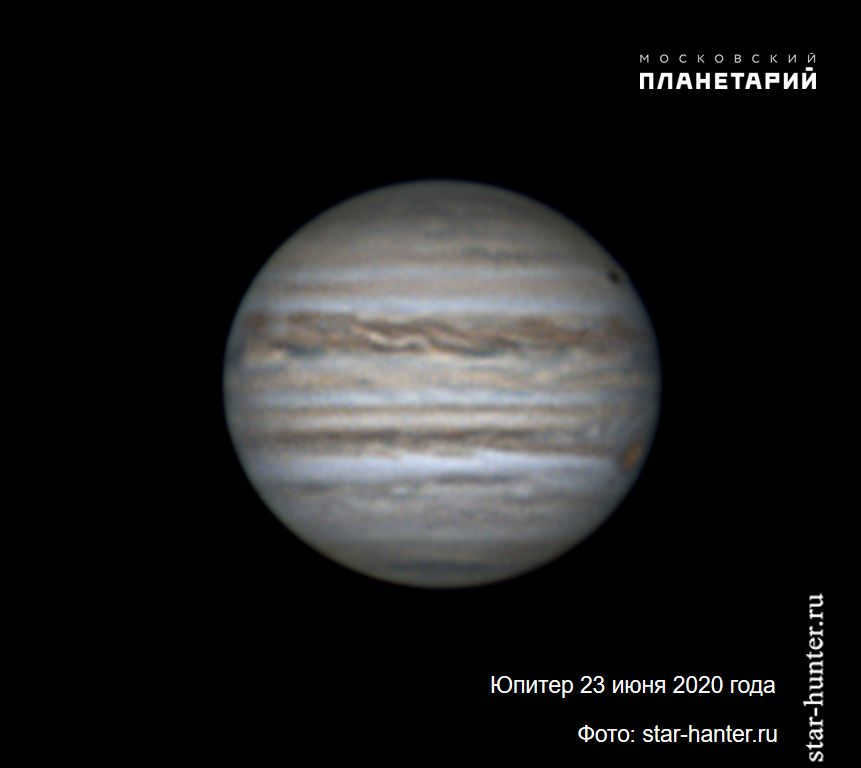
During the opposition, Jupiter shines with a sidereal magnitude of -2.9m, and its distance from Earth of 4.02 a. e. (60138,440 km) results in the largest visible diameter of Jupiter in the sky, measuring 49 arc seconds. This provides an opportunity to observe not only the bright satellites of the giant planet, but also to discern more details on its disk. For the best observation of Jupiter, it is recommended to use binoculars or a telescope.
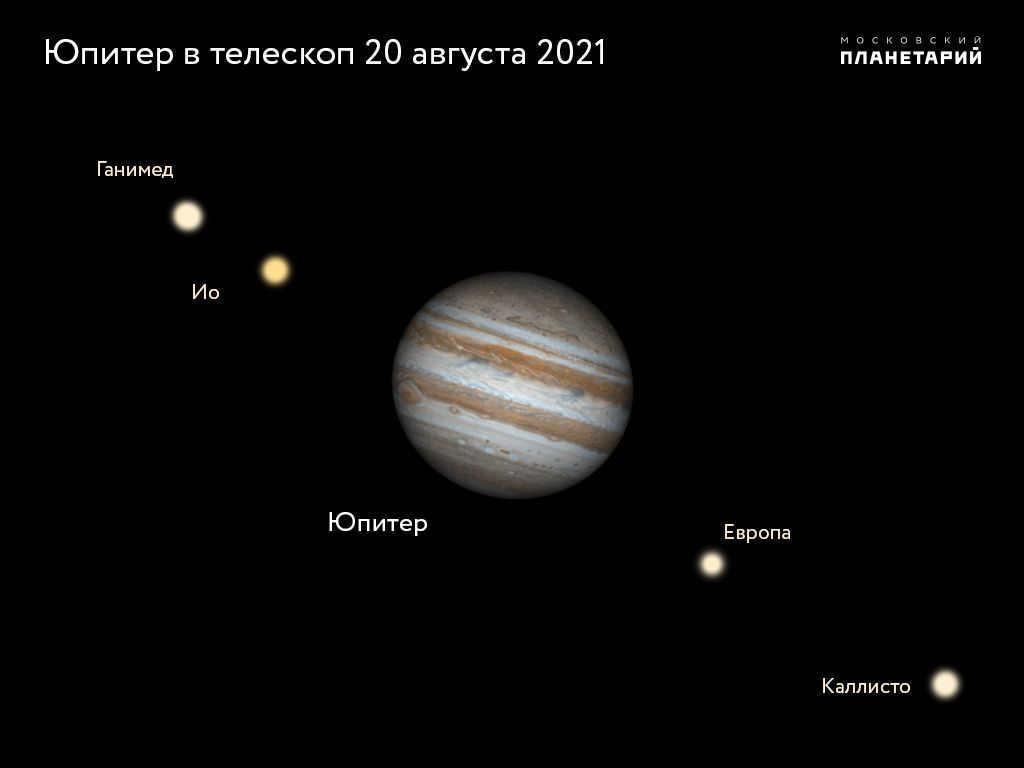
When observing Jupiter with an amateur telescope or powerful binoculars, it is possible to observe its four brightest satellites (Io, Europa, Ganymede, and Callisto) based on their distance from the planet. Due to their rapid orbital motion, these satellites constantly change their positions in relation to Jupiter and each other on a daily basis. Periodically, the satellites pass into Jupiter’s shadow, become hidden behind it, and even cross in front of the planet’s disk. All of these phenomena can be witnessed through a telescope. Currently, Jupiter is known to have a total of 79 satellites.
Optimal circumstances for Jupiter observation commenced during the early summer and will persist until the conclusion of October 2021 (period of retrograde motion of the celestial body in the firmament). Throughout this period, Jupiter occupies the most advantageous position in the sky for terrestrial spectators.
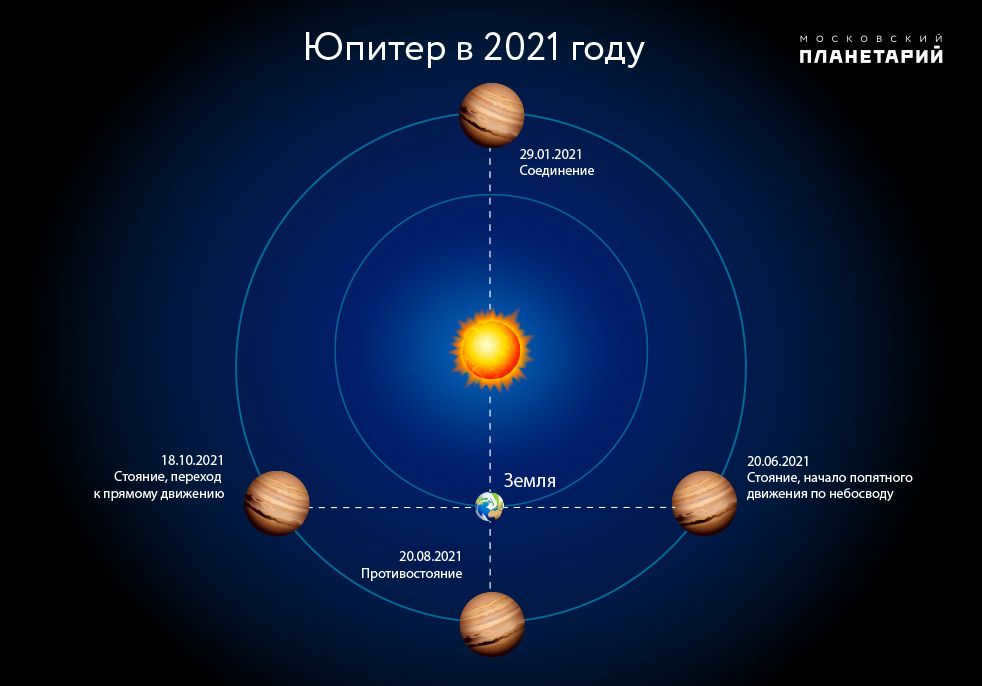
Jupiter’s positions in 2021:
On January 29, 2021, there will be a conjunction between Jupiter and the Sun.
On June 20, 2021, Jupiter will be stationary, marking the beginning of its sideways motion in the sky;
On August 20, 2021, Jupiter will be in opposition to the Sun;
On October 18, 2021, Jupiter will be stationary again, transitioning to direct motion.
Jupiter’s oppositions occur every year and repeat every 399 days. On August 20, 2021, during the opposition, Jupiter will be approximately 4.02 astronomical units away from Earth. (equivalent to 60,138,440 kilometers) from Earth.
The point of opposition for Jupiter is set to occur on September 26, 2022.
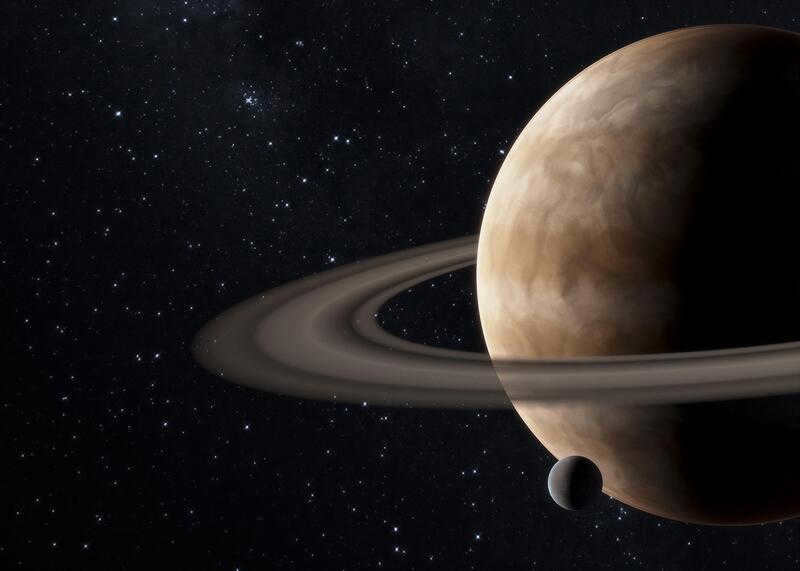
Jupiter and its moons have been extensively researched and remain a topic of discussion among prominent astronomers. Understanding their origins and future is crucial in unraveling the complex history of our solar system. Let’s consider the number of satellites that Jupiter currently possesses in the year 2021.
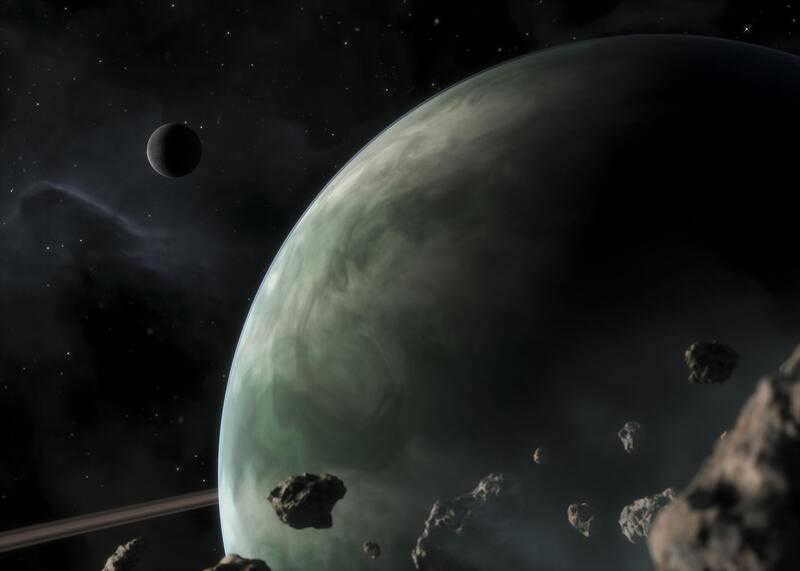
The Moons of an Unsuccessful Star
The gas giant is composed of helium and hydrogen, just like the Sun, but unlike the Sun, it does not undergo thermonuclear reactions in its core. To initiate such reactions, a mass at least 30 times greater is required.
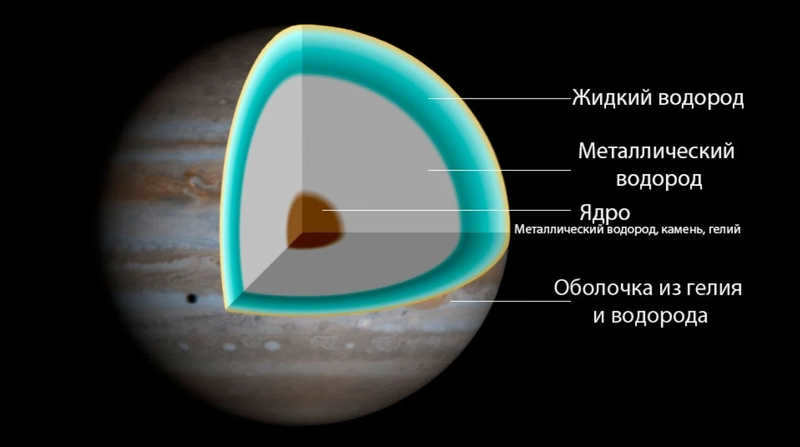
Nevertheless, within the boundless expanse of the cosmos, there exist brown dwarfs – substars with a mass 70 times larger than that of Jupiter, yet lacking the initiation of reactions.
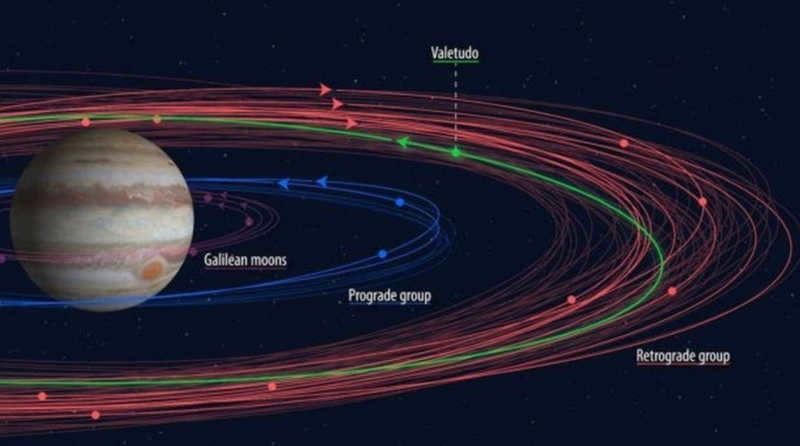
The total count of satellites it possesses is 79, and the approximated figure exceeds 100, which is the highest among all the planets in the solar system.
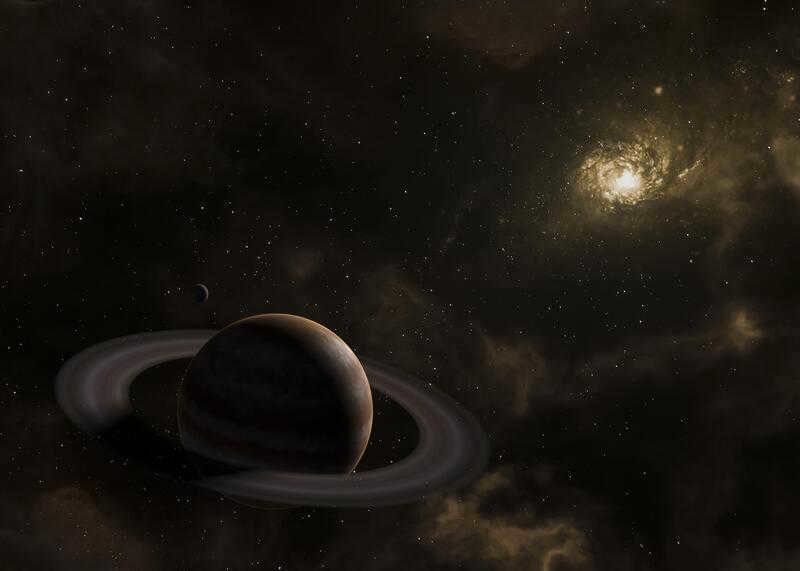
Traditionally, Jupiter’s satellites are named after various daughters and lovers of the supreme Roman god.
The most well-known are the initial 4 satellites, also known as Galileo’s satellites.
These satellites were first discovered by the renowned scientist, who famously exclaimed “and yet it moves”, in 1610. There was some debate over who actually discovered them, with Simon Marius being a contender. However, Marius’ names for the satellites have stood the test of time and continue to be used today.
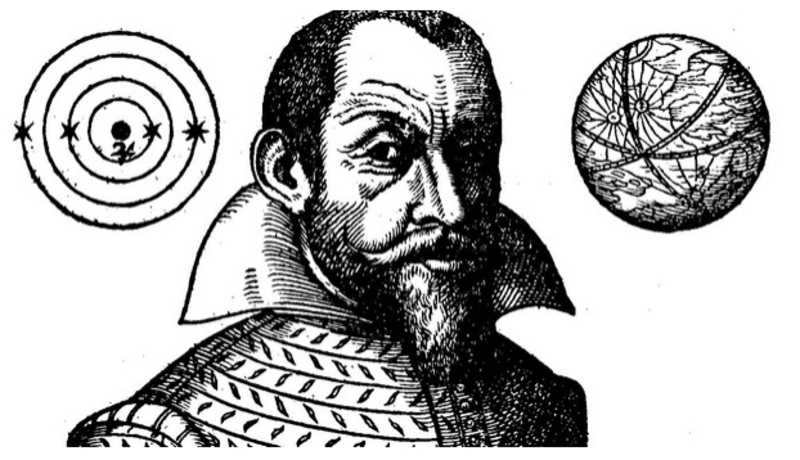
According to the research findings, Jupiter lacks the sufficient mass to undergo stellar fusion and transform into a star. Fortunately, from an earthly perspective, there are no indications that it will accumulate the necessary mass in the future.
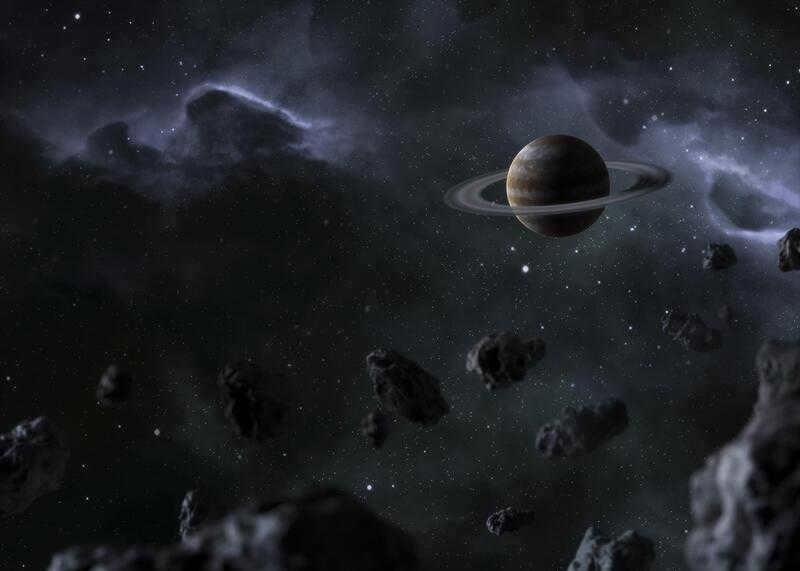
The mass of all objects that can potentially interact with Jupiter is not enough to form a star. Therefore, it is inaccurate to refer to our gas giant as a failed star. The term “failed” typically implies the presence of conditions or prerequisites, but in this situation, they are lacking.
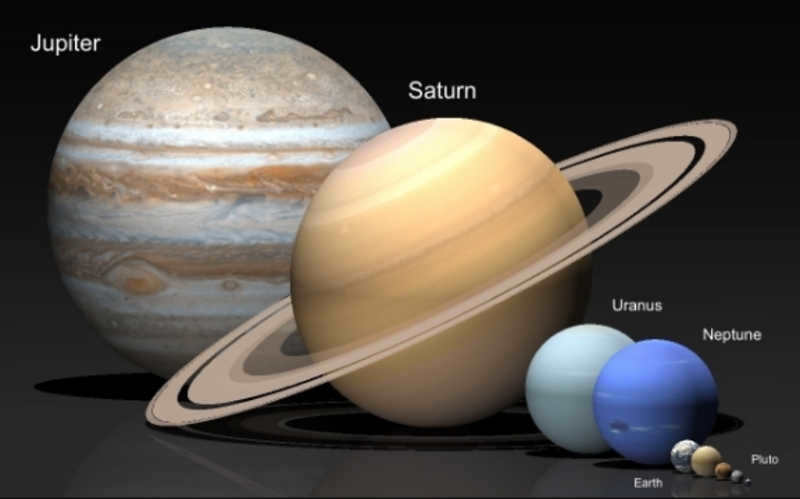
Jupiter’s Satellites and Their Significance in Advancing Astronomy
During Galileo Galilei’s observation, the primary satellites of Jupiter were observed for a brief period of time, typically lasting only a few days. This discovery led to the realization that not only the Earth, but also other celestial bodies, had satellites.
Jupiter was the initial recognized planet in the field of science to possess “satellites”.

Galileo, the apparatus fixed in the planet’s orbit, continues to be a subject of particular fascination. It is a peculiar phenomenon that scientists find intriguing.
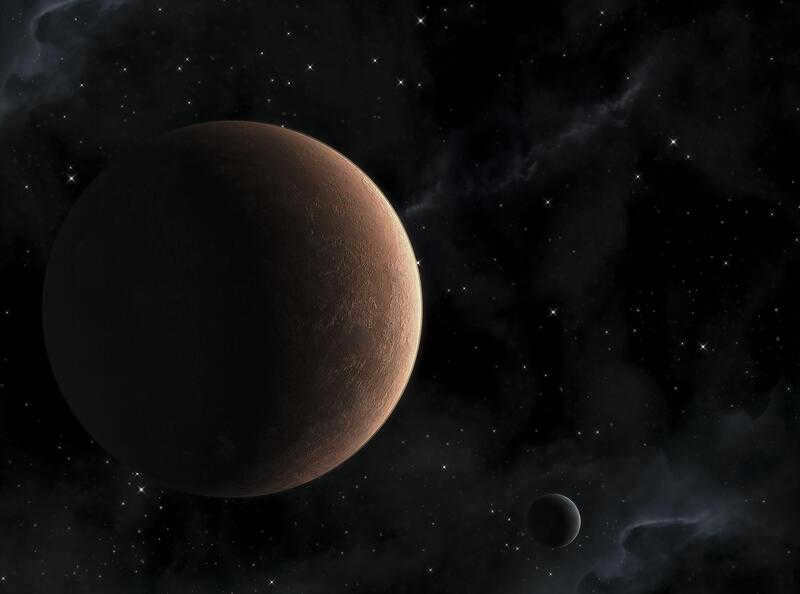
It was him who meticulously observed all of Jupiter’s satellites and documented the momentous arrival of Comet Shoemaker-Levy in 1994. After a span of 7 years in 2003, the spacecraft willingly sacrificed itself by plunging into the dense atmosphere of the gas giant, successfully transmitting crucial data about its composition for the very first time. In the year 2022, there are plans for a satellite expedition from EKA, and in 2025, a journey to Europa is scheduled.
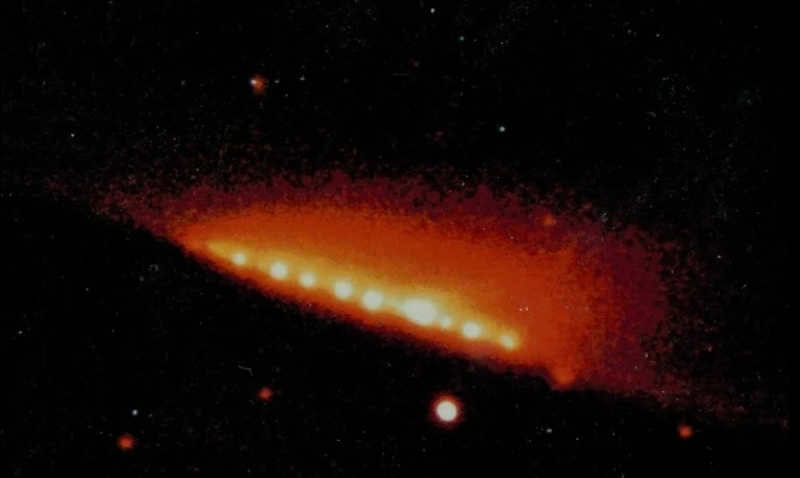
Categories of Jupiter’s moons
Jupiter’s satellites can be divided into four categories: primary, inner, outer, and irregular.
- The primary satellites are the largest moons of Jupiter and are located closest to the planet. They were first observed by Galileo Galilei in 1610.
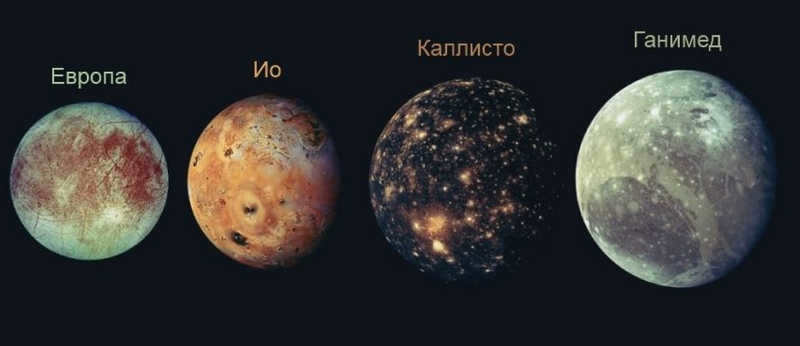
- Internal planets are situated close to the edge of the planet’s orbit. They do not differ significantly from the main planets in terms of characteristics.
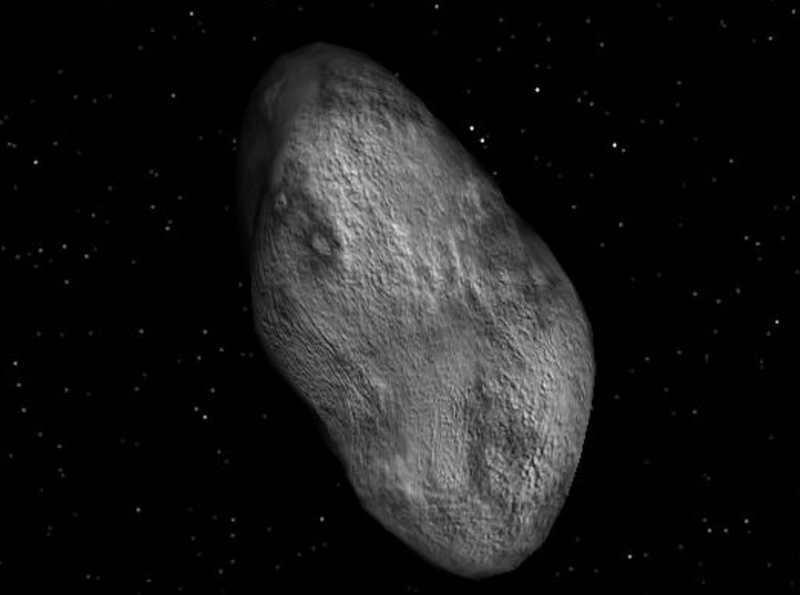
- Outlying – an extensive assemblage of entities exhibiting a vast array of attributes. These entities can be found at the outermost extremity of the orbital trajectory.
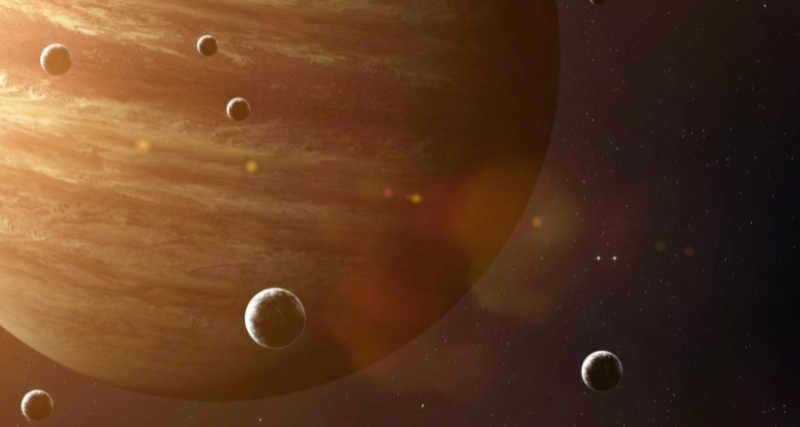
Main (Galilean) moons
Ganymede is Jupiter’s largest moon and the largest moon in the solar system (slightly bigger than 2 moons). Callisto is the next smaller moon, followed by Europa and Io.
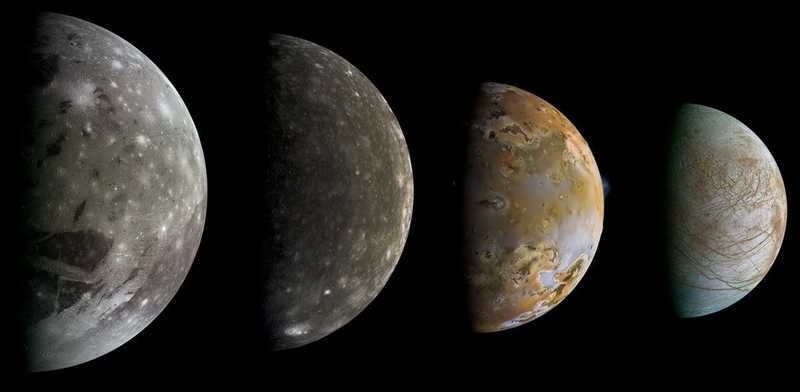
Ganymede is unique among known satellites in that it possesses its very own magnetosphere. It was given its name as a tribute to the Greek prince, who was both the son of the king of Troy and the divine cupbearer. When it comes to the field of astronomy, it is a common practice to draw inspiration from the mythologies of various cultures around the globe.
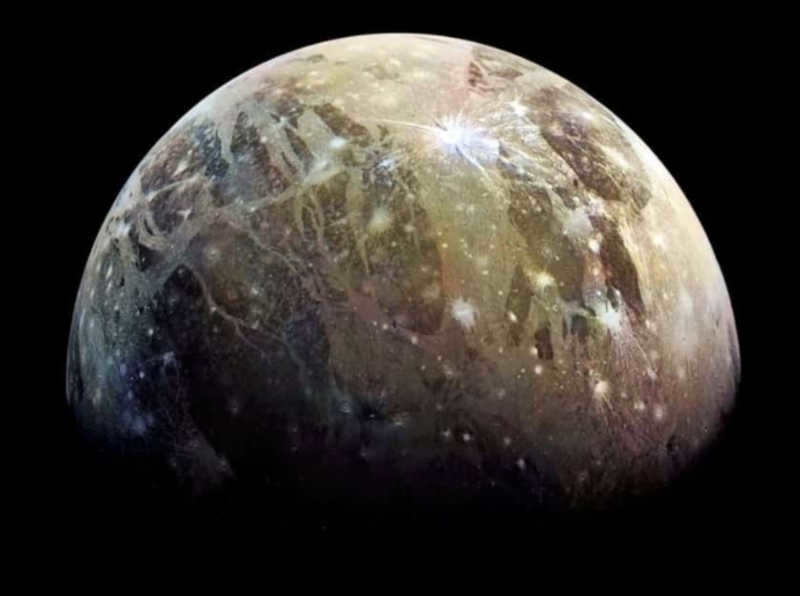
The privilege of selection primarily lies with the individual who made the discovery. This celestial body possesses its own distinct atmosphere, consisting of altered levels of oxygen. It is hypothesized to contain a briny ocean sandwiched between layers of ice, potentially harboring microscopic organisms.
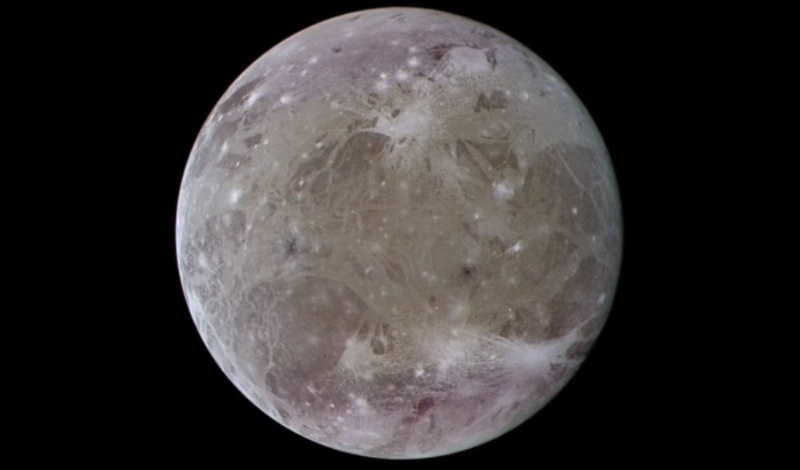
Callisto, one of Jupiter’s four main satellites, is known for being the furthest away. It has a low surface density and is covered with craters, some of which are as large as 3000 km in diameter.
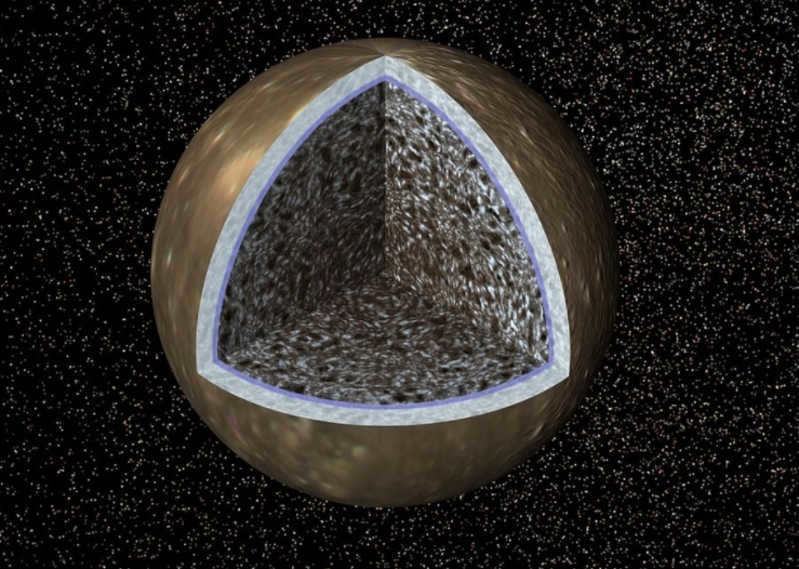
The name of this planet was given in honor of Lycaon, who was the daughter of a ruler from the early days of Arcadia, an ancient Greek city-state. It possesses a delicate atmosphere.
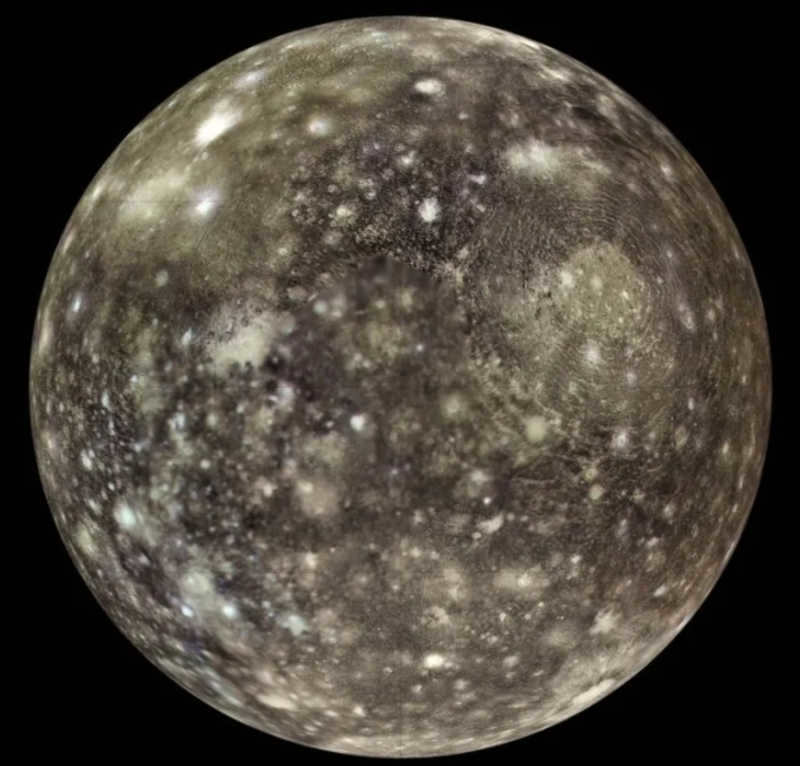
Io, one of Jupiter’s moons, is known for its active volcanic activity, boasting approximately 400 active volcanoes on its surface.
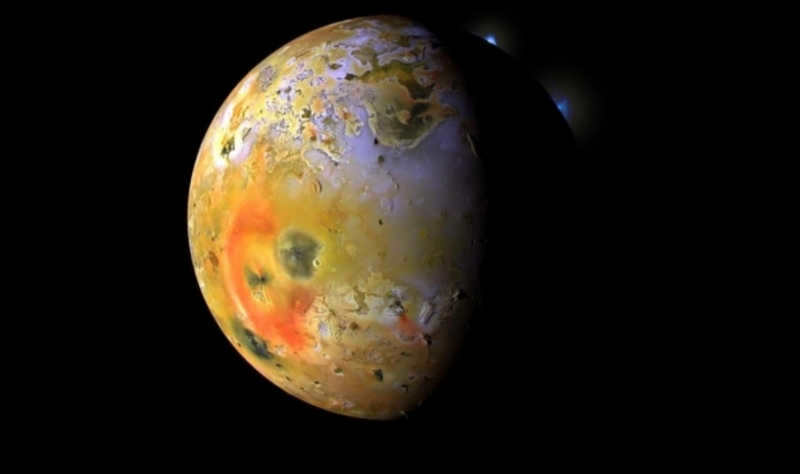
Jupiter’s composition is primarily composed of liquid iron with a considerably less dense atmosphere.
The name “Juno” is derived from the priestess Juno (Hera), who was the wife of the supreme god.
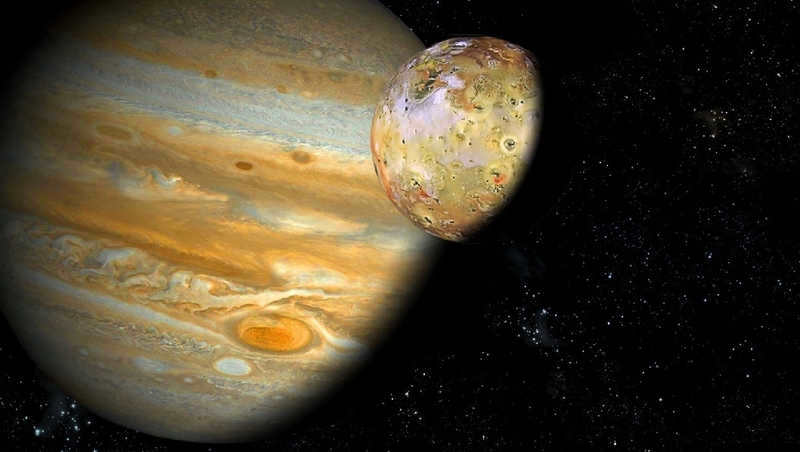
Europa, the tiniest moon in the primary cluster, is composed of two distinct layers – an icy exterior and a liquid water interior. Due to the significant likelihood of containing microscopic life, a mission to Europa is scheduled for 2025.
Europa was named after the Queen of Crete, who was once a humble Phoenician noblewoman.
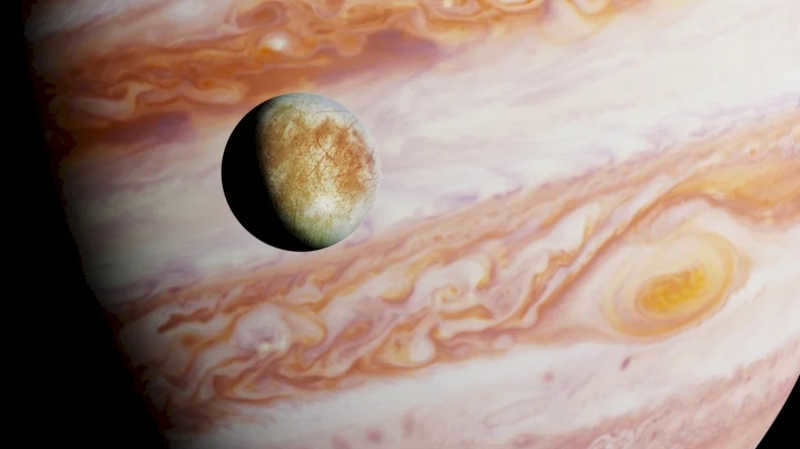
Jupiter’s Inner Satellites
There are also four satellites orbiting Jupiter with a diameter smaller than 200 km.
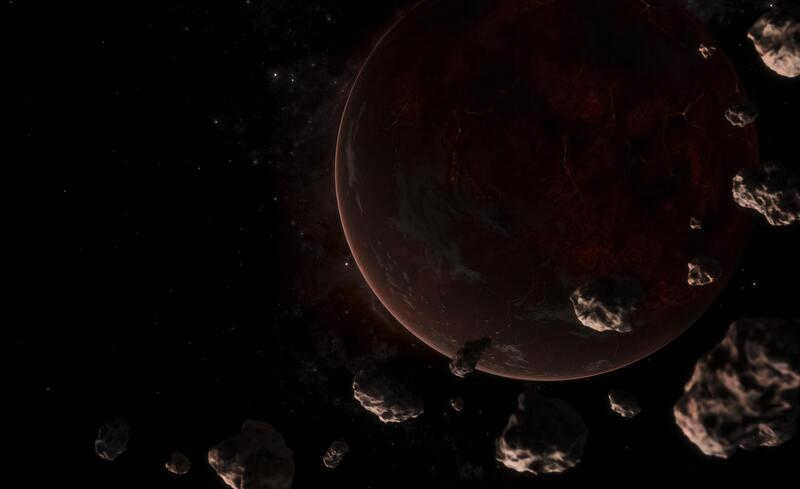
The group consists of: Metis, Adrastea, Almathea, and Thebes.
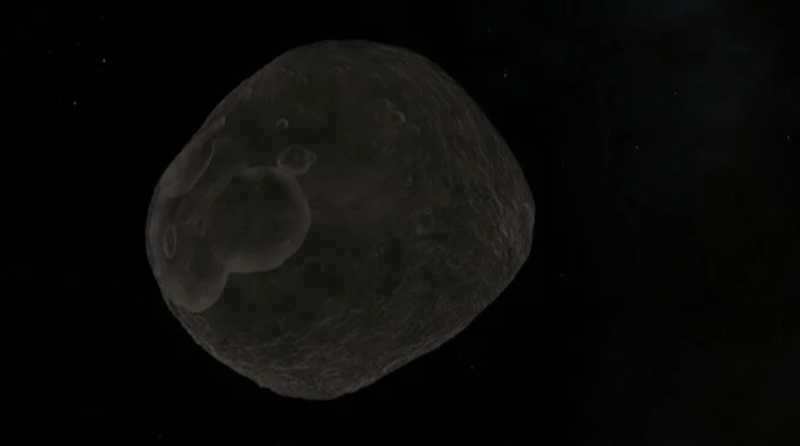
Metis, which was only found in 1979, is the satellite that orbits Jupiter at the nearest distance.
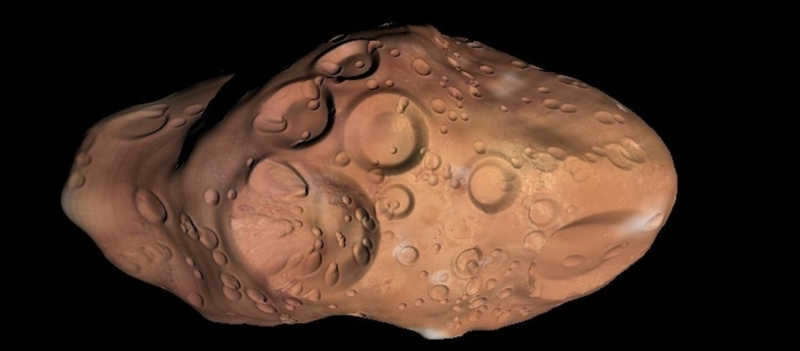
Almathea, the largest and most irregularly shaped object in the group, stands out the most. Its distinctive dark red hue indicates that it may have originated from outside our local system. This unique coloring is not found anywhere else in our solar system. The moon is named after Zeus’ first wife, Almathea, as a tribute to her.
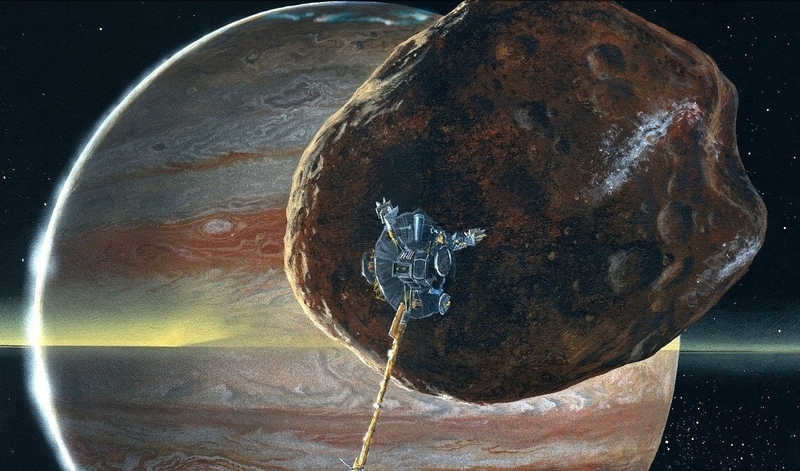
One notable aspect of the inner cluster is its proximity to Jupiter, as it is within a distance of less than 200,000 km. Additionally, its trajectory aligns closely with that of the main cluster.
Satellites Outside Jupiter’s Orbit
Out of the named satellites, there are presently 59 that fall into this category.
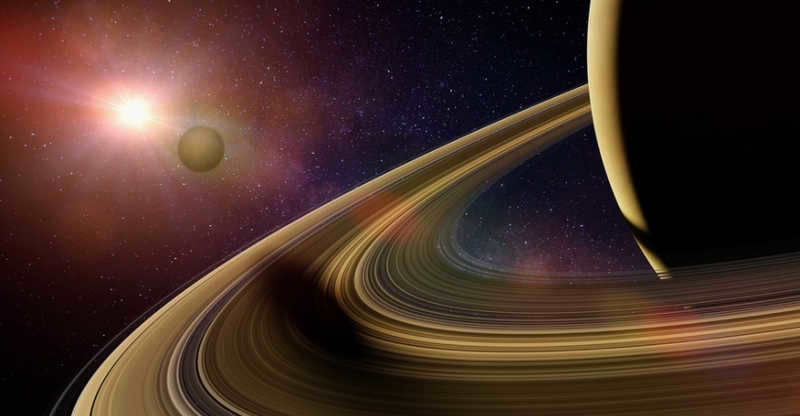
As previously stated, not all of Jupiter’s satellites have been definitively identified. The outer ones are located further away from the gas giant than the inner ones. They vary significantly in size, but they generally follow similar paths.
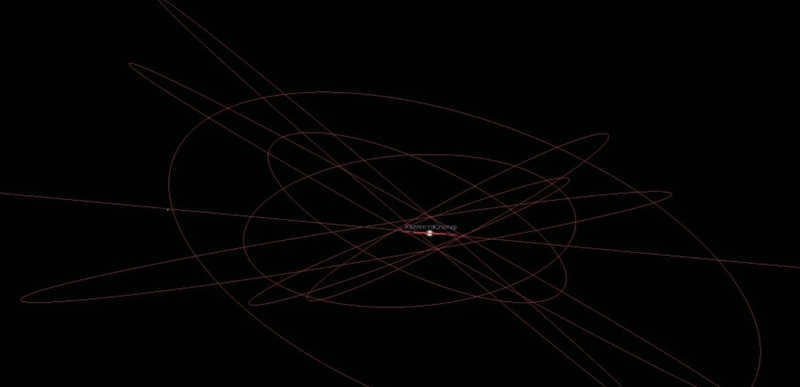
Here is a comprehensive inventory of all the satellites that have been identified:
The irregulars consist of a collection of celestial bodies with retrograde orbits. This category encompasses entire clusters of diminutive entities that are believed to have originated from a single parent body.
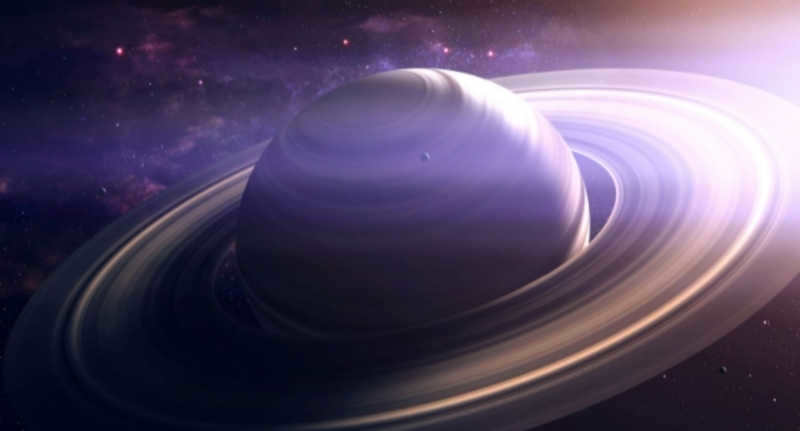
As of 2021, Jupiter has a total of four known moons: Carme, Ananke, Pasiphae, and Himalia.
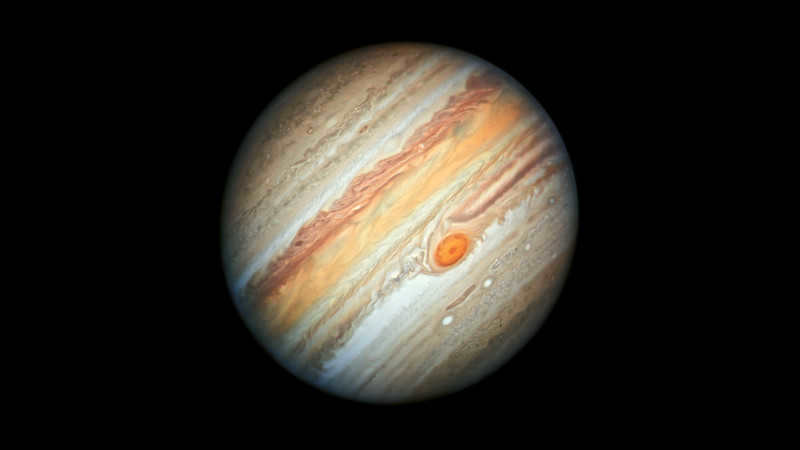
This summer, the sky is being adorned by two radiant planets – Jupiter and Saturn. They will continue to embellish the sky throughout the fall, gradually moving apart. Just last year, they were inseparable, with a momentary merging that made them appear as a single celestial body.
Jupiter, being the fastest planet among the giants, naturally took the lead. It is not only the largest but also the brightest. Saturn, trailing behind in the constellation, has already vanished from the sight of many amateur stargazers (who are not particularly skilled at navigating the stars). However, there are several other factors contributing to this, such as the bright nights of June and July, high levels of light pollution in urban areas, and the relatively low altitude of both planets above the horizon, although Jupiter still maintains a slightly higher position.
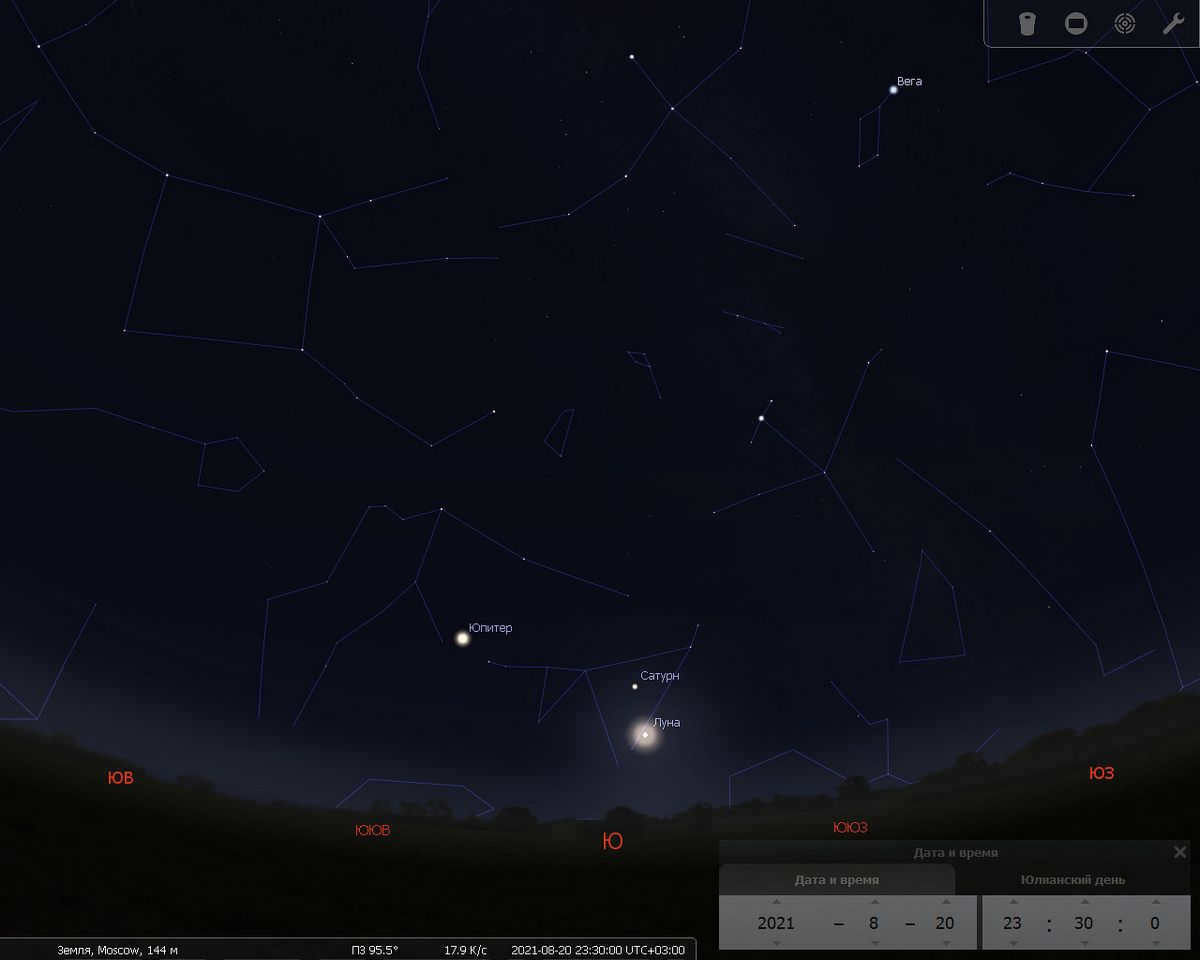
On the 20th of August 2021, Jupiter will engage in a celestial encounter with the Sun, presenting an excellent opportunity for observation. However, the nights surrounding the opposition are also quite favorable.
Allow me to refresh your memory on the nature of such an encounter
Jupiter, being an outer planet, has an orbit that greatly surpasses the Earth’s orbit in size. It is positioned over 5 times further away from the Sun compared to the Earth. Moreover, the distance between Earth and Jupiter fluctuates each year, either drawing closer or moving farther apart.
Undoubtedly, individuals tend to find it more convenient to observe a celestial body when it is in proximity. This holds true for Jupiter. However, this is not always the case. Take, for instance, the inner planets such as Mercury and Venus. When these planets are closest to Earth, it becomes inconvenient to observe them due to their positioning in the direction of the Sun.
Conversely, when it comes to Jupiter, the situation is entirely different. When Jupiter is at its closest point to Earth, it assumes a position in direct opposition to the Sun in the sky. This particular planetary configuration is aptly named “Opposition”.
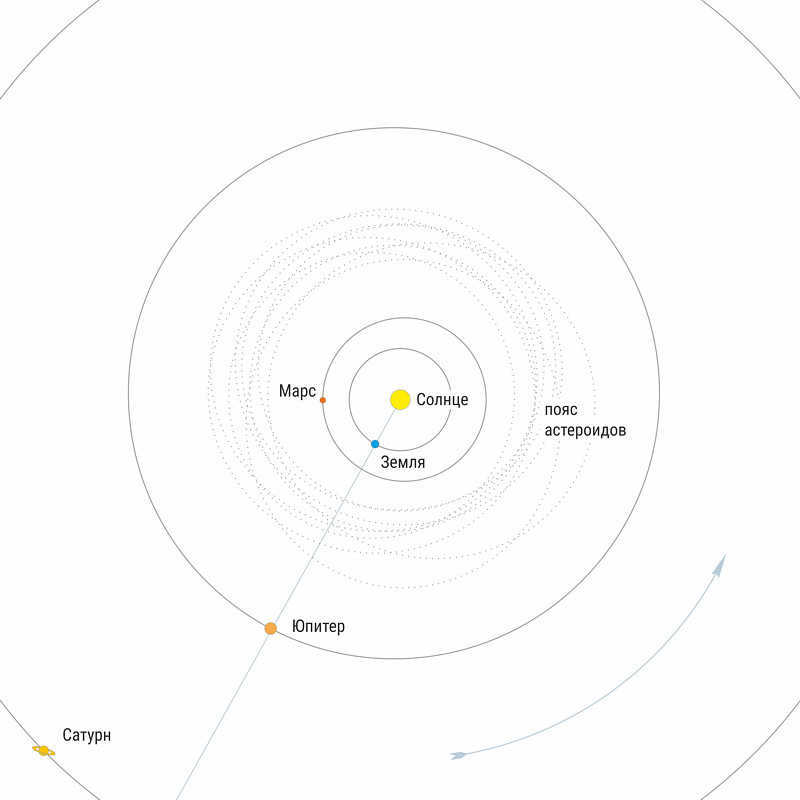
One accurate image is more than sufficient to grasp the situation without excessive words.
The image depicts the Earth and Jupiter aligned in a straight line on the same side of the Sun during the opposition. This arrangement results in the shortest distance between the two planets.
However, not all oppositions are created equal. While we are familiar with significant Mars oppositions, what about those of Jupiter? Do all of its oppositions carry the same significance?
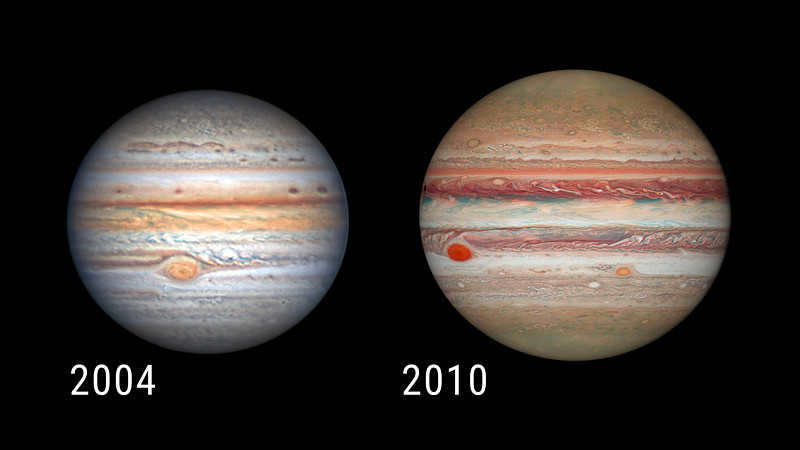
Similar to Mars’ grand oppositions, Jupiter’s special oppositions are also referred to as grand oppositions.
In actuality, the difference in distance to Jupiter from opposition to opposition does not vary as much as it does for Mars. It is worth noting that for the red planet, the distance during opposition ranges from 55 to 102 million kilometers – a difference of almost 2 times. For Jupiter, the range is slightly over 10%, with distances varying from 590 to 665 million kilometers. Consequently, the visual characteristics of the largest of the planets change accordingly with each opposition.
Brilliance: ranging from -2.45m to -2.95m.
Equatorial diameter: ranging from 44″ to 50″ (seconds of arc).
However, planets remain quite distant celestial bodies and when observing them, each increase in apparent size is highly valuable. Therefore, it goes without saying that during the Great Jupiter Confrontation, the planet receives more attention than ever before, unless something extraordinary occurs… and it certainly does.
In terms of proximity, Jupiter’s oppositions occur annually. However, there is a one-month difference between each occurrence. For instance, if this year’s opposition takes place in August, next year’s will be in September. It is also possible (and it does occur) for certain years to pass without a confrontation – such as in 2013 and 2025.
The Great Jupiter oppositions take place every 12 years, albeit with a slight variation.
This year’s clash is not the Grand Clash, but next year will be precisely the Grand Clash. However, it is crucial to comprehend that the confrontations preceding and following the Grand Clash do not deviate much from the Grand Clash.
The highest brightness and apparent equatorial diameter that Jupiter will achieve on August 20 will be: -2.9m and 49″ respectively – nearly identical to a year from now. And the sole factor that will make the subsequent opposition considerably more favorable is Jupiter’s altitude above the horizon in our latitudes. It is slightly lower this year.
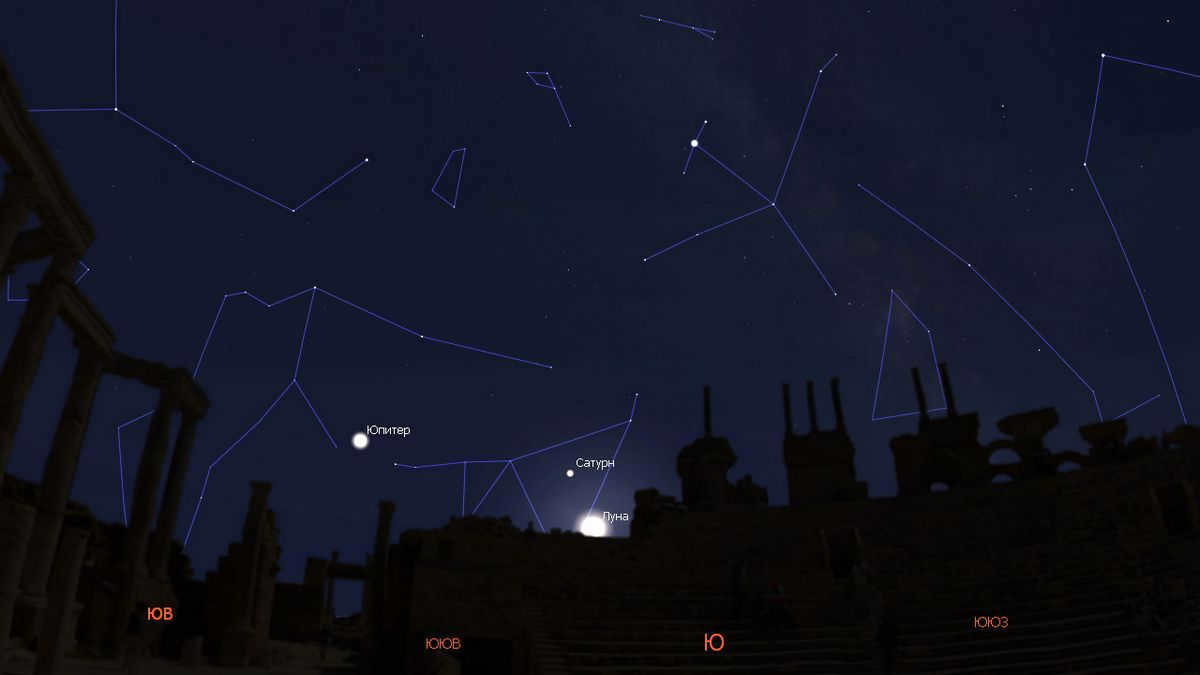
However, during August-September of this year, Jupiter appears very bright and sizable. It would be a shame not to take advantage of this opportunity.
So, what can you observe with a budget telescope on Jupiter and its surroundings?
First and foremost, you can see the four largest satellites of the planet. They are visible even with 6x binoculars, although it is recommended to use a stronger instrument. After all, Galileo Galilei made this discovery using a telescope with a 34x magnification.
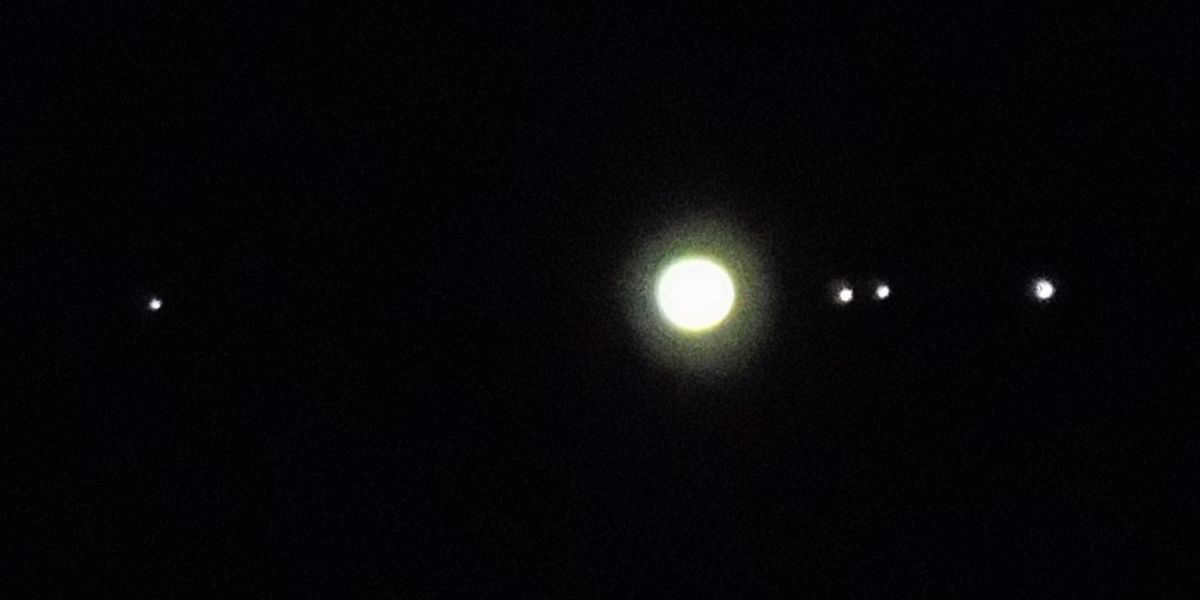
It is worth mentioning that the positional appearance of Galileo’s satellites is in a constant state of flux. At times, this phenomenon can be observed within a matter of minutes, as the satellites emerge from behind Jupiter, then retreat back into its shadow. On occasion, two satellites may appear to be so close that they appear as a single entity, yet within a short span of time, they separate and become distinctly visible.
A variety of phenomena regularly occur in Jupiter’s satellite system. Here is a compilation of the primary ones:
- The transit of a satellite across Jupiter’s disk (entering and exiting)
- The passage of a satellite’s shadow across Jupiter’s disk (entering and exiting)
- The obscuring of a satellite by Jupiter or the emergence of a satellite from behind Jupiter
- The eclipse of a satellite by Jupiter’s shadow (start and end)
In addition, there are eclipses and obscuring of satellites by each other, as well as the phenomenon known as “satellite disappearance,” where no satellite-like objects can be observed near Jupiter in a small telescope, as if they don’t exist at all.
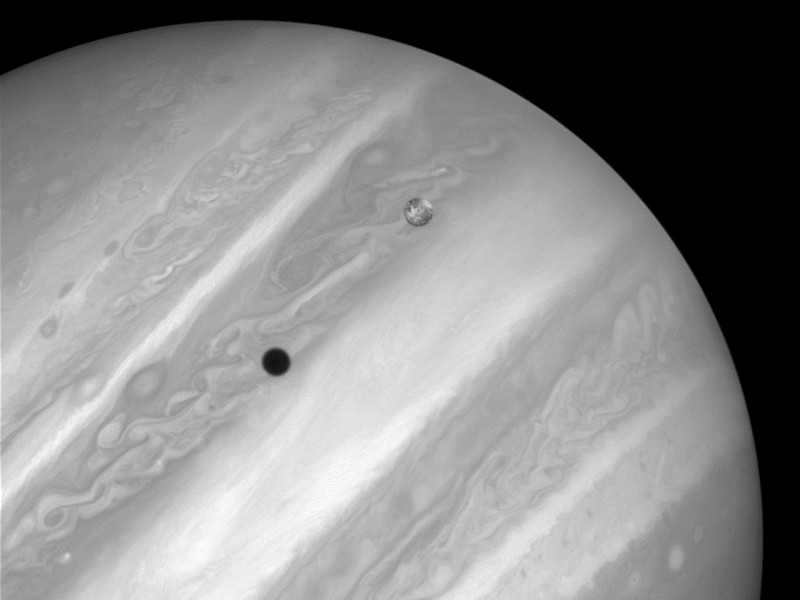
Galileo suggested using the events occurring in the Jupiter system, particularly among its satellites, to accurately measure time.
Why would one need to do this, you may wonder? Can’t we simply rely on the stars for timekeeping?
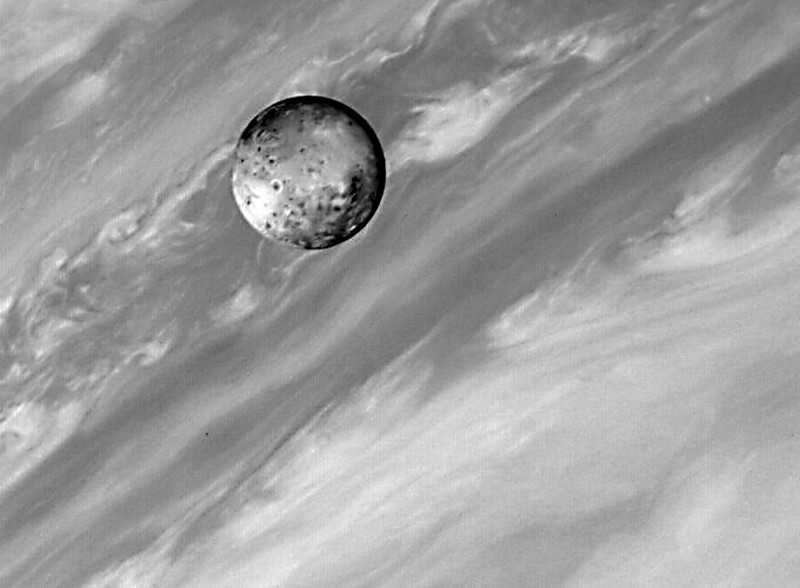
Undoubtedly, even in the time preceding Galileo by several centuries, there existed a method of determining the time based on the Sun and the stars. Nonetheless, these methods were only effective if the observer possessed precise knowledge of their location.
There was a discrepancy in this method of determining nautical coordinates, which became apparent quite quickly. During Jupiter’s opposition, the tables with pre-calculated moments of phenomena in the Jupiter satellite system aligned well with reality. However, when Jupiter was in close proximity to the Sun during conjunction, the error could reach up to 15 minutes. This significant error greatly affected the accuracy of determining the coordinates. It is quite perplexing how such a discrepancy can be tolerated in the scientific field of astronomy, where precision is of utmost importance!
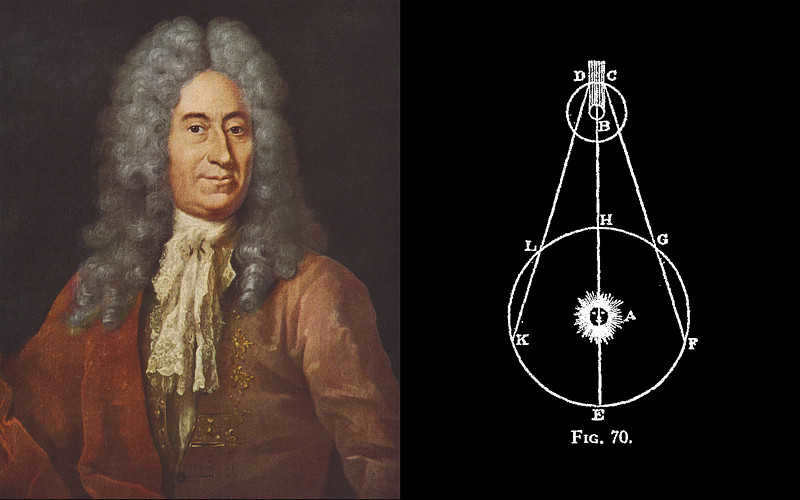
In 1676, Olaf Rømer, a Danish astronomer at the Paris Observatory, found a solution to the problem. Rømer proposed that the delay in detecting the phenomena is due to the increased distance between Earth and Jupiter. When Jupiter is further away, it takes longer for light to travel and convey information about events in Jupiter’s system, especially when it is positioned behind the Sun compared to when it is in opposition.
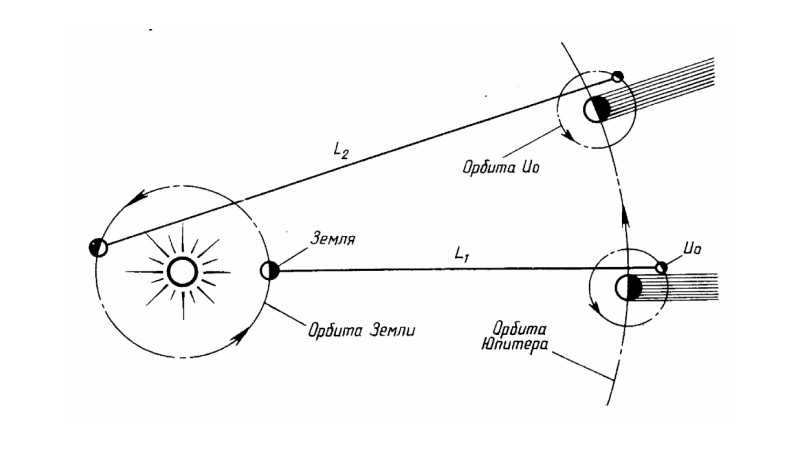
It was an incredibly insightful explanation. Olaf Rømer was the individual who initially calculated the velocity of light. Prior to this, it was believed that light was so swift that it traveled – if not instantly through the entire cosmos – at such a rapid pace that humans would never be capable of measuring its speed.
That eliminates one fewer never.
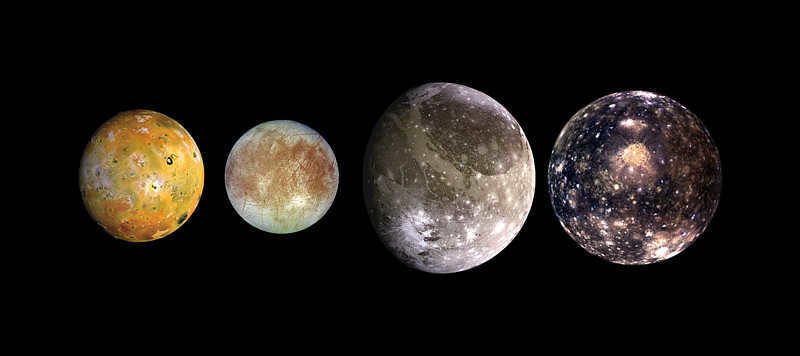
However, Jupiter did not have any satellites for an extended period of time.
It was not until 1892, nearly three centuries after Galileo, that the fifth satellite, Amalthea, was discovered. Unlike Galileo’s satellites, Amalthea is relatively small, measuring only a couple of hundred kilometers across and has a non-spherical shape. Nowadays, it is evident that Jupiter no longer has anything comparable to Galileo’s satellites, as the number of known satellites orbiting the gas giant is approaching one hundred. The rest of Jupiter’s companions are irregularly shaped small stones, which are either captured asteroids or remnants of previous collisions and disruptions. This could also explain why Jupiter has rings…
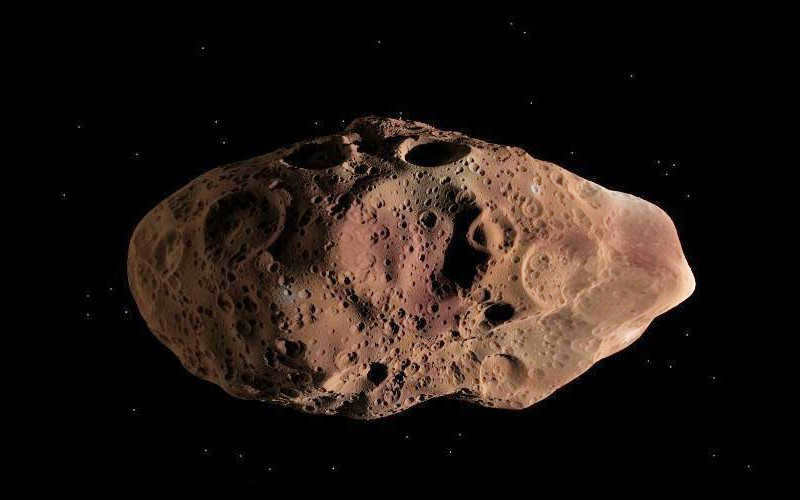
You cannot see Jupiter’s rings with any telescope.
However, it is important to note that even before Voyager 1’s journey, Soviet astronomer Sergei Konstantinovich Vsekhsviatsky predicted the existence of rings around Jupiter. It is uncertain what exactly led to Vsekhsviatsky’s accurate predictions – whether it was his exceptional observational skills, his ability to subconsciously analyze scientific data, or a sixth sense that allowed him to make groundbreaking assumptions without any observational or theoretical evidence. Nevertheless, Vsekhsviatsky’s predictions often proved to be true.
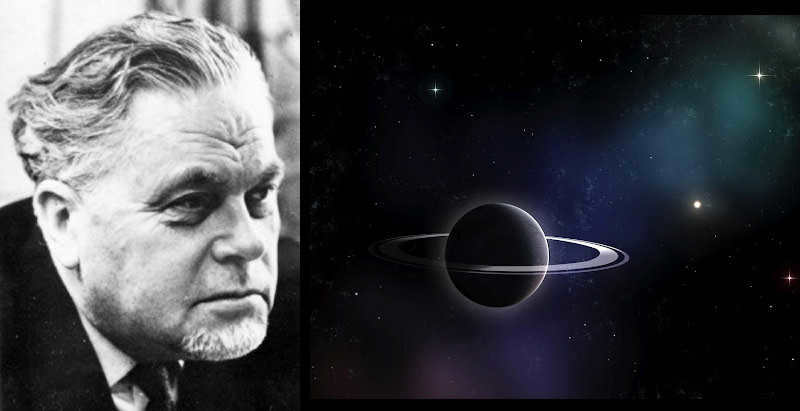
Regrettably, the rings of Jupiter were discovered to be quite feeble. Although the initial two probes, Pioneer-10 and Pioneer-11, ventured near this planet, they did not detect any rings. Voyager-1 managed to capture photos of the rings only in a backlight situation, when Jupiter eclipsed the Sun.
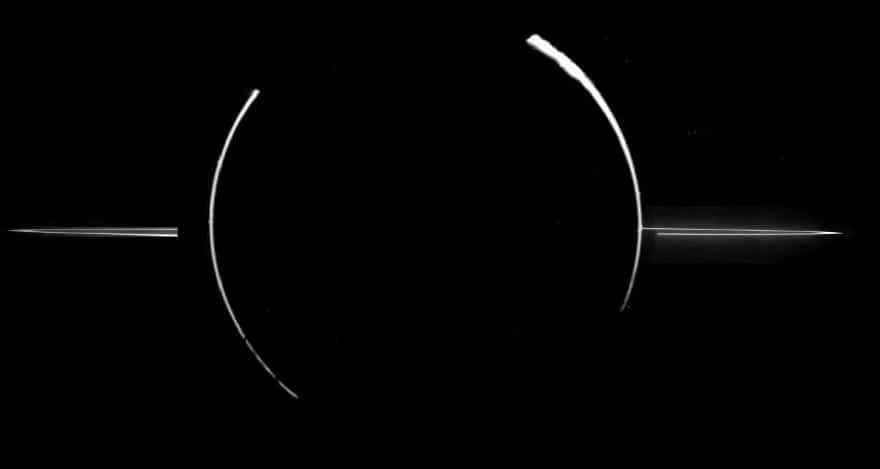
However, Jupiter possesses an additional celestial phenomenon that accompanies it and follows its commands just like its satellites and rings – it consists of at least three groups of asteroids, which are abundantly present: the Greeks, the Trojans, and the Hildas.
Each of these groups contains thousands of individual celestial objects.
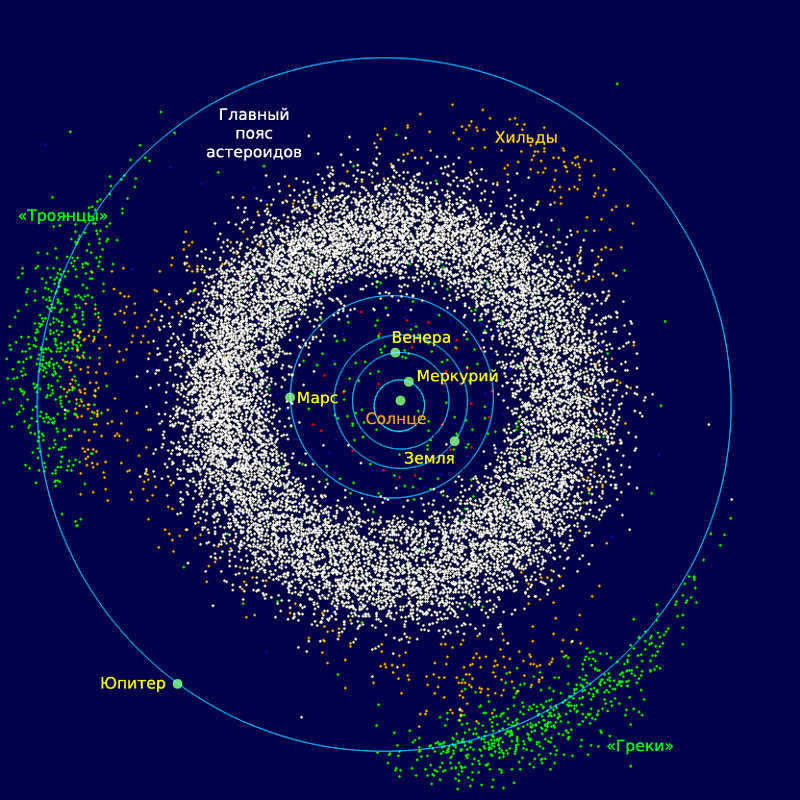
Incidentally, similar celestial objects can be found in the orbits of Earth, Mars, Saturn, Uranus, and Neptune – exhibiting the same functional dependency. Venus, on the other hand, does not have a complete Trojan asteroid – it appears to have one, but intermittently breaks away from it. As for Mercury, it does not possess anything of that nature at this time.
The situation with Hilda’s family is a bit more complex. They are not firmly anchored to any specific reference points, but rather move between L3 and L5, then to L4, and back to L3 – decelerating near these points, and experiencing substantial acceleration during the migratory phases.
Undoubtedly, Jupiter’s powerful gravitational force is to blame for preventing these asteroids from leading independent lives.
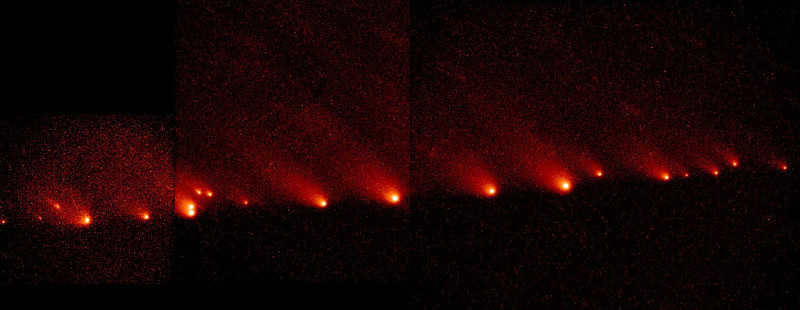
Jupiter governs the largest group of comets. This group consists of 172 comets with short orbital periods that are limited to the orbit of Jupiter or have an orbital period of less than 20 years. In the past, all of these comets have come close to the largest planet in our solar system, which has influenced their orbit and prevented them from returning to the Oort cloud. The Oort cloud is the source of new comets that enter our nearby solar space, and these comets are made up of blocks of water ice containing frozen pebbles and dust.
In recent years, Jupiter has captured at least three comets. It is likely that throughout its history, countless celestial bodies have fallen into its interior.
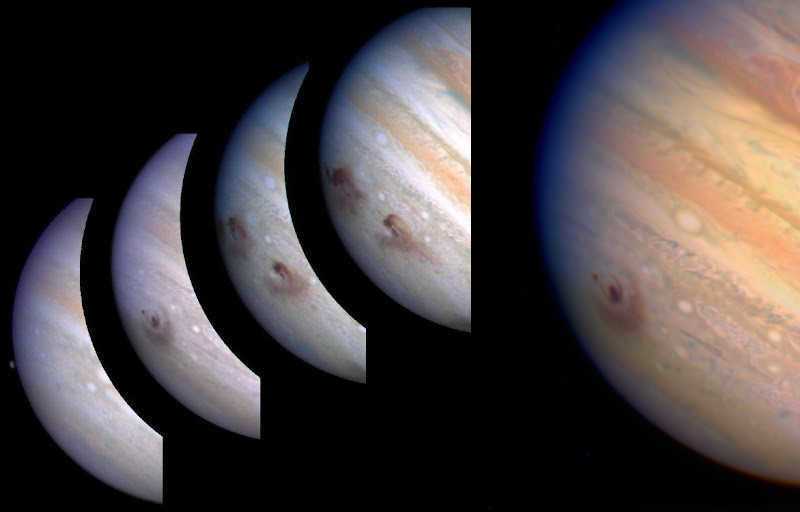
What other surprises did astronomers discover when they first observed Jupiter through a telescope?
Jupiter has the greatest flattening at its poles compared to any other planet in the solar system. This is due to its incredibly fast rotation. A day on Jupiter lasts less than 10 hours, making it the fastest rotating planet in our solar system. However, it’s important to note that this rapid rotation only occurs at the equatorial zone, where the day lasts 9 hours and 50 minutes. The middle latitudes have a daily revolution of 9 hours and 55 minutes, while the polar regions fall just short of reaching the 10-hour mark.
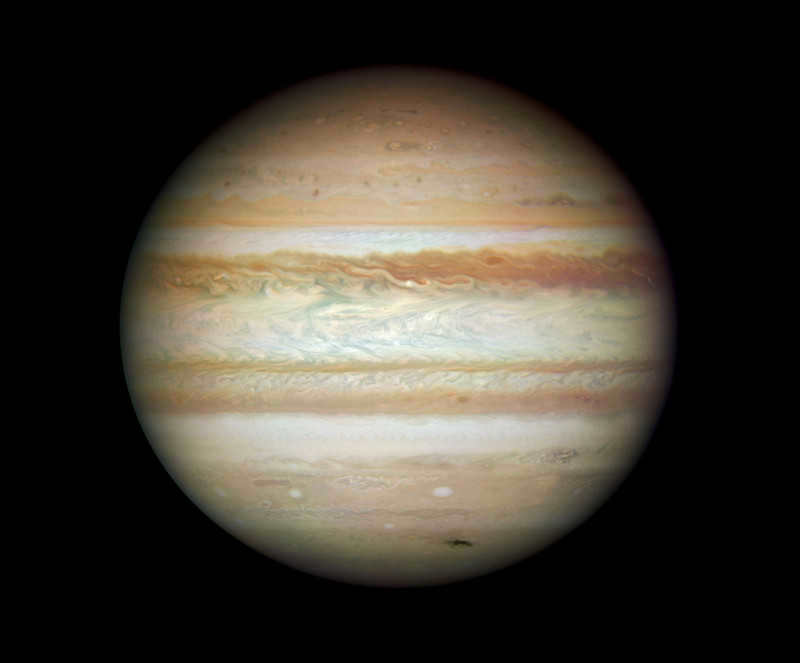
When astronomers discuss the daily rotation of Jupiter, they are referring to the visible upper layer of the atmosphere observed through a telescope. In reality, they are referring to the rotation of the cloud layer. What occurs within the depths of Jupiter and whether there is a completely different concept of a “day” remains unknown. Interestingly, the upper cloud layer of Venus completes a revolution around the planet in just 4 Earth days, while the solid part of Venus rotates much more slowly, taking 243 Earth days to complete one revolution.
For Jupiter, there is likely no significant variation in rotational speed between the different layers of the atmosphere. The evidence for this lies in the polar compression, which measures at 6.5%. This suggests that the entire mass of the planet rotates quickly around its axis.
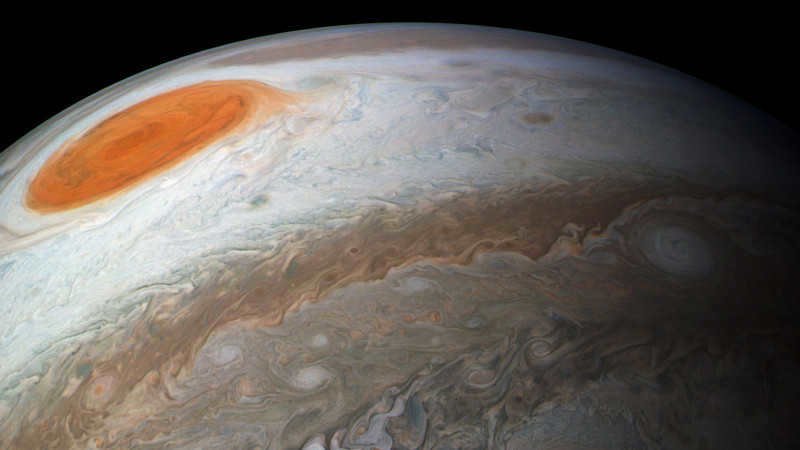
The initial discovery of this phenomenon dates back to the time of Galileo and it remains as the largest known cyclone in the solar system, persisting for over four centuries. However, recent observations indicate that its size has decreased by half within the last century, although it still remains several times larger than Earth. It is uncertain whether future generations will have the opportunity to witness the majestic Great Red Spot, as it continuously drifts across Jupiter’s southern hemisphere, engulfing other tornadoes and whirlwinds. Additionally, it serves as a crucial reference point for determining planetary longitude on Jupiter. The disappearance of the Great Red Spot poses a challenge for planetologists in terms of accurately establishing the physical coordinates of other atmospheric formations on the planet. This is because the remaining formations on Jupiter are even more transient and have significantly shorter lifespans.
Cloud bands – the southern and northern equatorial belts can be observed even in the smallest telescope on Jupiter. With a larger telescope, two more thin belts are visible, and with a strong enough instrument, numerous atmospheric belts can be distinguished.
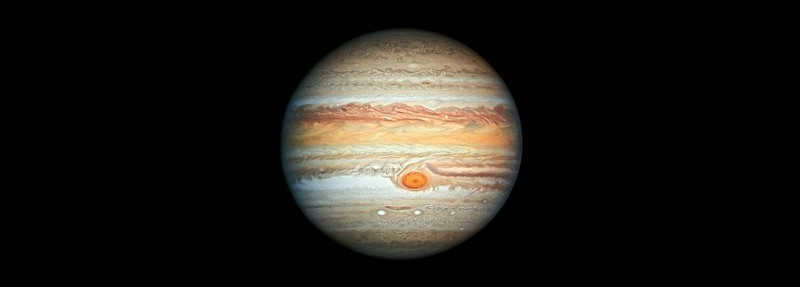
Recently, the Southern Equatorial Belt, which had been under constant observation by Huygens and Cassini, mysteriously vanished. It was Anthony Wesley, an avid astronomy enthusiast, who first noticed its disappearance and alerted the Hubble telescope to quickly redirect its gaze towards the gas giant. Once again, Jupiter was meticulously examined through the watchful eyes of Earth’s most advanced orbital technology.
The atmospheric phenomena occurring on Jupiter can be likened to a “boiling” process… or perhaps more accurately, a “cryo-boiling” process, given the planet’s extremely low temperatures in its visible region. However, beneath its frigid exterior, Jupiter’s atmosphere is teeming with dynamic activity, as evidenced by photographs captured by unmanned research probes.
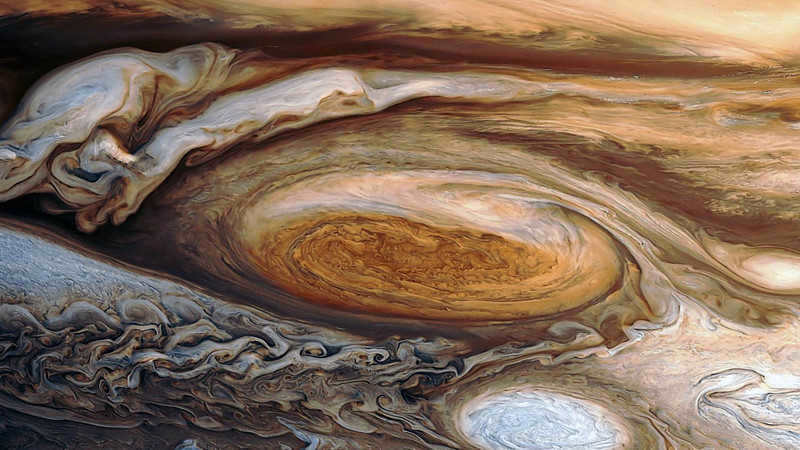
What is Jupiter composed of?
The primary component of Jupiter is hydrogen, which makes up approximately 90% of its composition. The remaining elements include helium and other elements from the periodic table of Mendeleev, accounting for less than 1% of the planet’s composition.
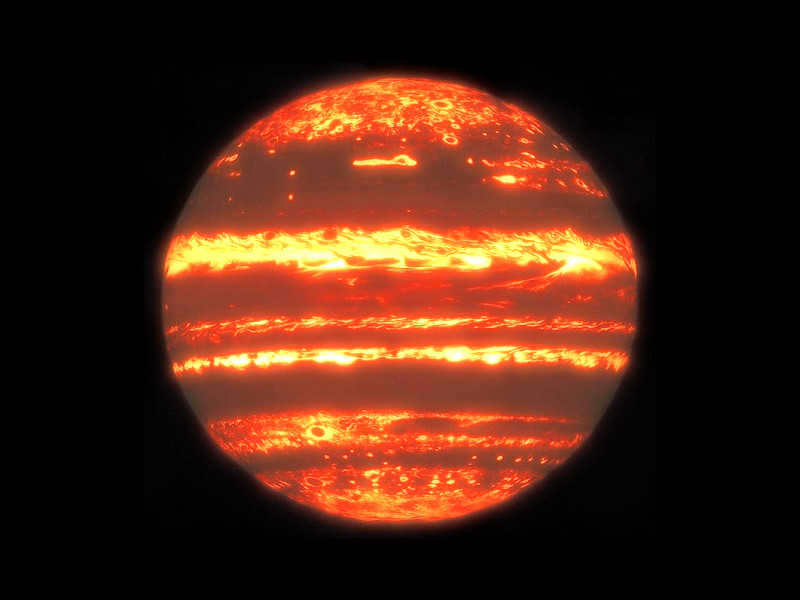
Undoubtedly, Jupiter will not transform into a star. According to contemporary standards for sustaining stable thermonuclear reactions, it would necessitate a mass that is twenty times greater than its current mass. Certainly, even with the addition of comets and asteroids, Jupiter will never accumulate such a significant mass. Furthermore, there is no other source from which it can acquire the required mass, even if it manages to assimilate all the planets within the Solar System.
Nevertheless, it is important to acknowledge Jupiter’s position in terms of mass ratio: it is three hundred times more massive than Earth and a thousand times “lighter” than the Sun. Additionally, it is two and a half times more massive than all the other planets combined within the Solar System.
In terms of diameter, Jupiter falls directly in the middle between Earth and the Sun, measuring ten times larger than the former and ten times smaller than the latter. The symmetry is truly captivating.
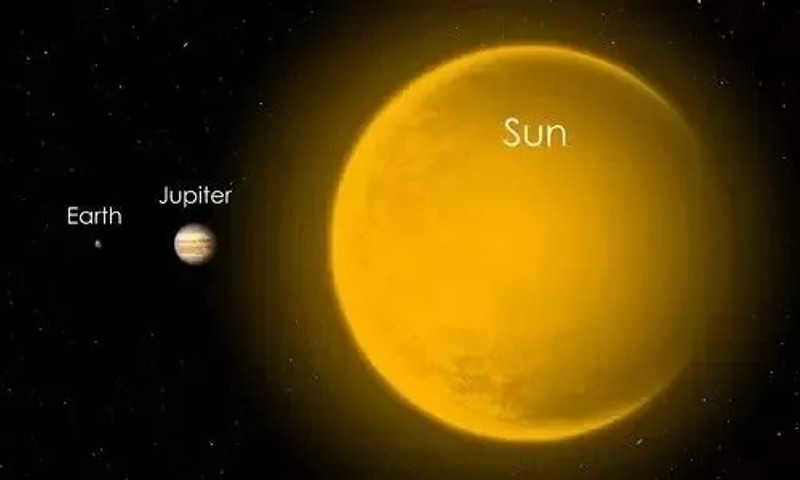
Over the past few years, there have been speculations about the potential existence of life on some of Jupiter’s moons. Two of the most promising candidates are Io and Europa. Io is known for its thermal zones surrounding active volcanoes, while Europa is believed to have a vast ocean beneath its icy surface. However, scientists are also exploring the possibility of unique forms of life within Jupiter’s atmosphere. As a result, research projects are being developed to deploy airships that can float among the clouds of Jupiter and investigate the potential existence of cryo-life in these extreme environments.
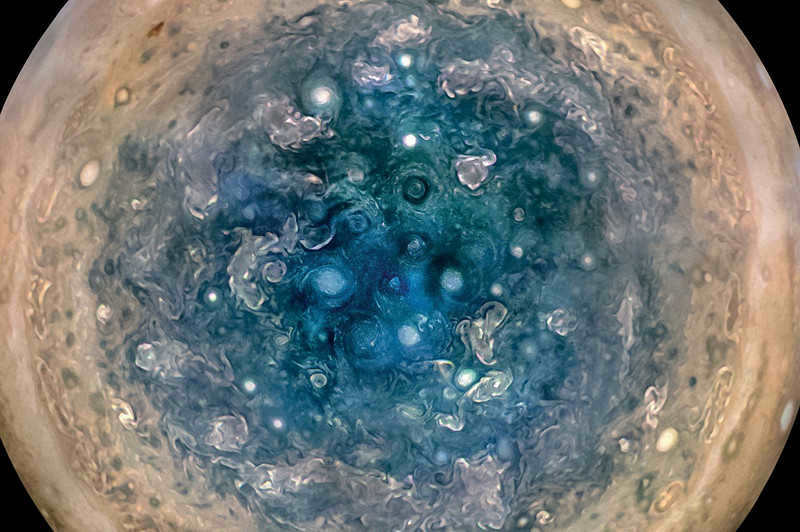
Undoubtedly, there are also more practical ventures in progress, which involve landing on the satellites and directly examining samples. I believe we will witness the realization of these daring projects.
At present, the Juno spacecraft is orbiting in the Jupiter system. Initially, its mission was set to conclude in 2021. However, the spacecraft is still fully operational and can continue functioning for several more years. In any case, its mission has been extended until 2025, and there is a possibility of further extension.
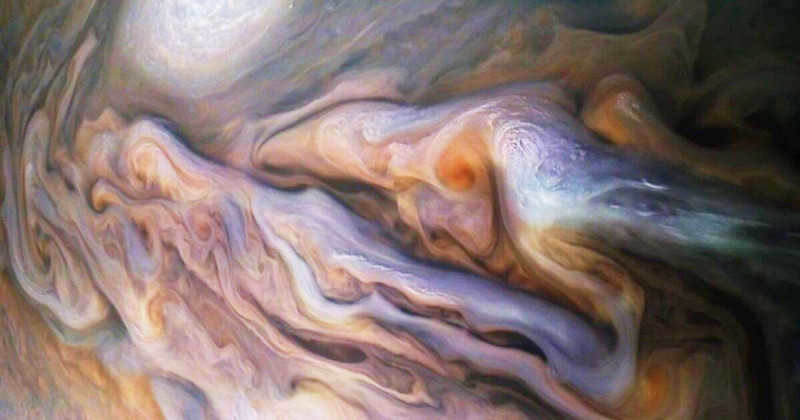
In the dark nights of August 2021, Jupiter can be observed shining in the vicinity of the constellations Aquarius and Capricorn. Its movement can be described as sideways, or retrograde according to astrology. During oppositions, all planets exhibit this sideways motion in loops.
Following the opposition, on the nights of August 21/22 and 22/23, the Full Moon will be in close proximity to Jupiter. This celestial rendezvous will occur approximately once a month.
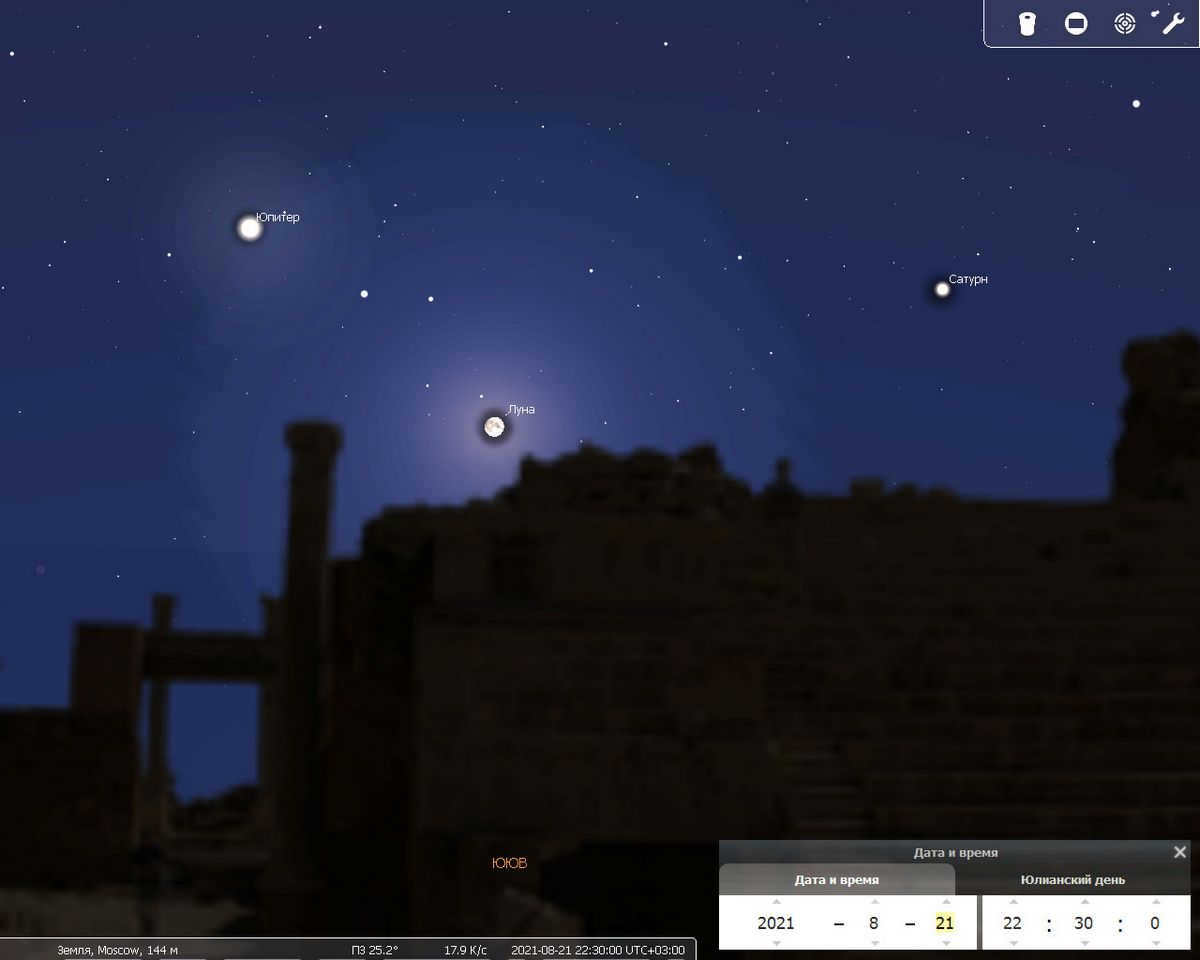
From mid-October onwards, Jupiter will be in a lateral movement and gradually edging closer to Saturn, which will be in close proximity throughout this period, situated in the constellation of Capricorn. However, after this, Jupiter will revert back to its forward motion towards the constellation Aquarius, a transition that will only occur around mid-December.
Wishing you a delightful stargazing experience!
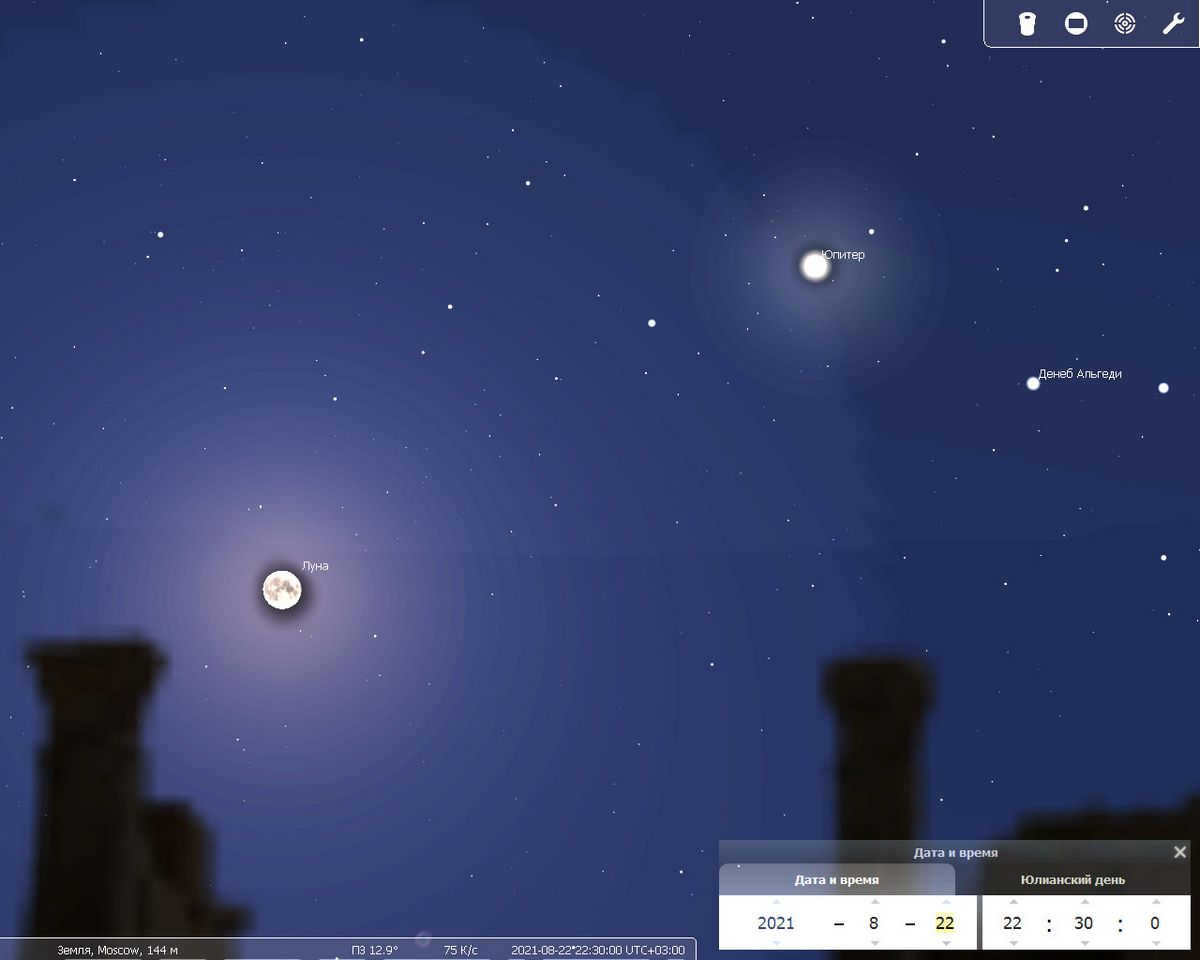
Music Application
I have created a musical composition that is dedicated to the planet Jupiter.
The song titled “Under Jupiter’s Influence” portrays the hypothetical journey of the Juno spacecraft during the time when this music was composed. It is featured in the album “Music of the Celestial Spheres – Part 6 – The Tale of a Fallen Star”, which is available on our website. You can enjoy the complete album and purchase it in digital format or order the physical CD. Here is the link:

Jupiter is often referred to as “The Failed Star” by astronomers. Without a doubt, Jupiter holds a unique position in the Solar System, primarily due to its size, which is nearly 2.5 times larger than the combined size of all the other planets. Additionally, it emits powerful radiation, second only to the radiation emitted by the Sun.
Jupiter’s Moons
While Jupiter may not have given birth to any stars, it boasts its own fascinating “system within a system”. Unlike other planets, Jupiter is surrounded by a multitude of moons. The exact number of moons orbiting Jupiter remains uncertain, as scientists estimate there to be at least 100, although only 79 have been officially identified thus far.
The moons of Jupiter are typically classified into three categories: Galilean, inner, and outer. The Galilean moons, which include Europa, Io, Callisto, and Ganymede, were first observed by Galileo in 1610 and were named after ancient heroes.
Io
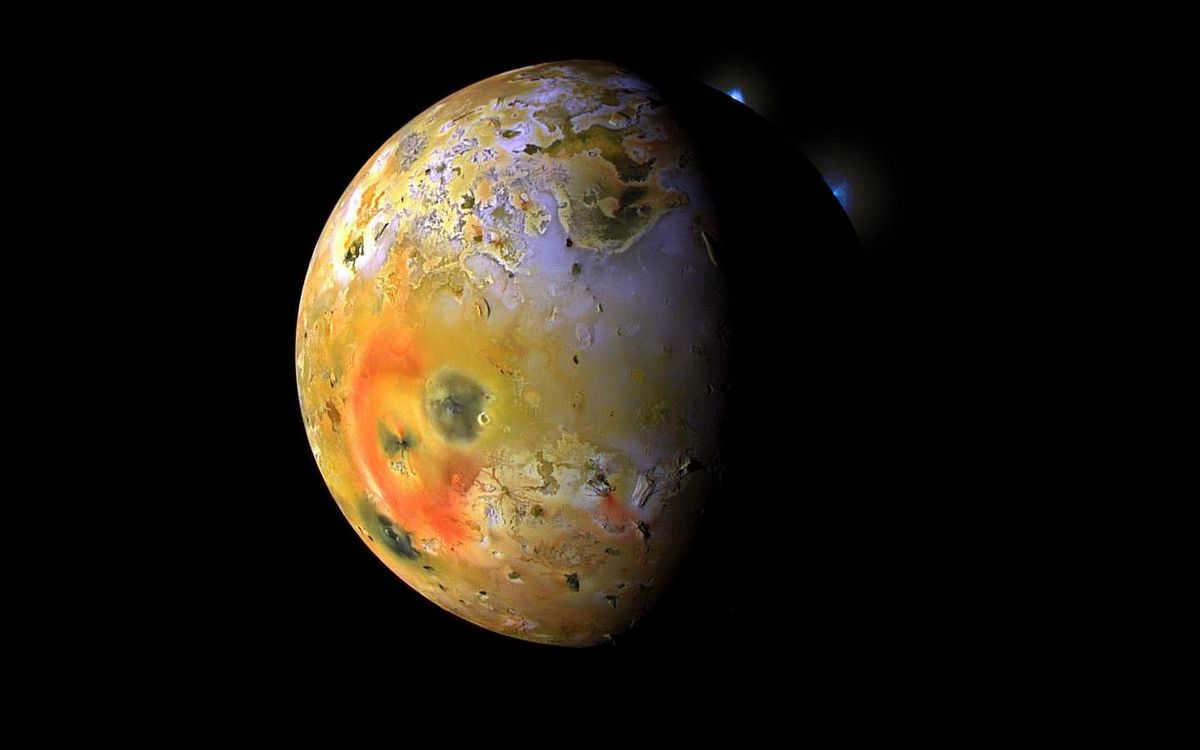
Io is the closest of Galileo’s satellites to Jupiter and is widely known for its remarkable volcanic activity, making it the most active volcanic object in the solar system. Its surface is covered with volcanic craters, which spew lava of various colors, ranging from yellow to brown and even black. The orange color of Io’s surface is predominantly formed by the products of these volcanic eruptions.
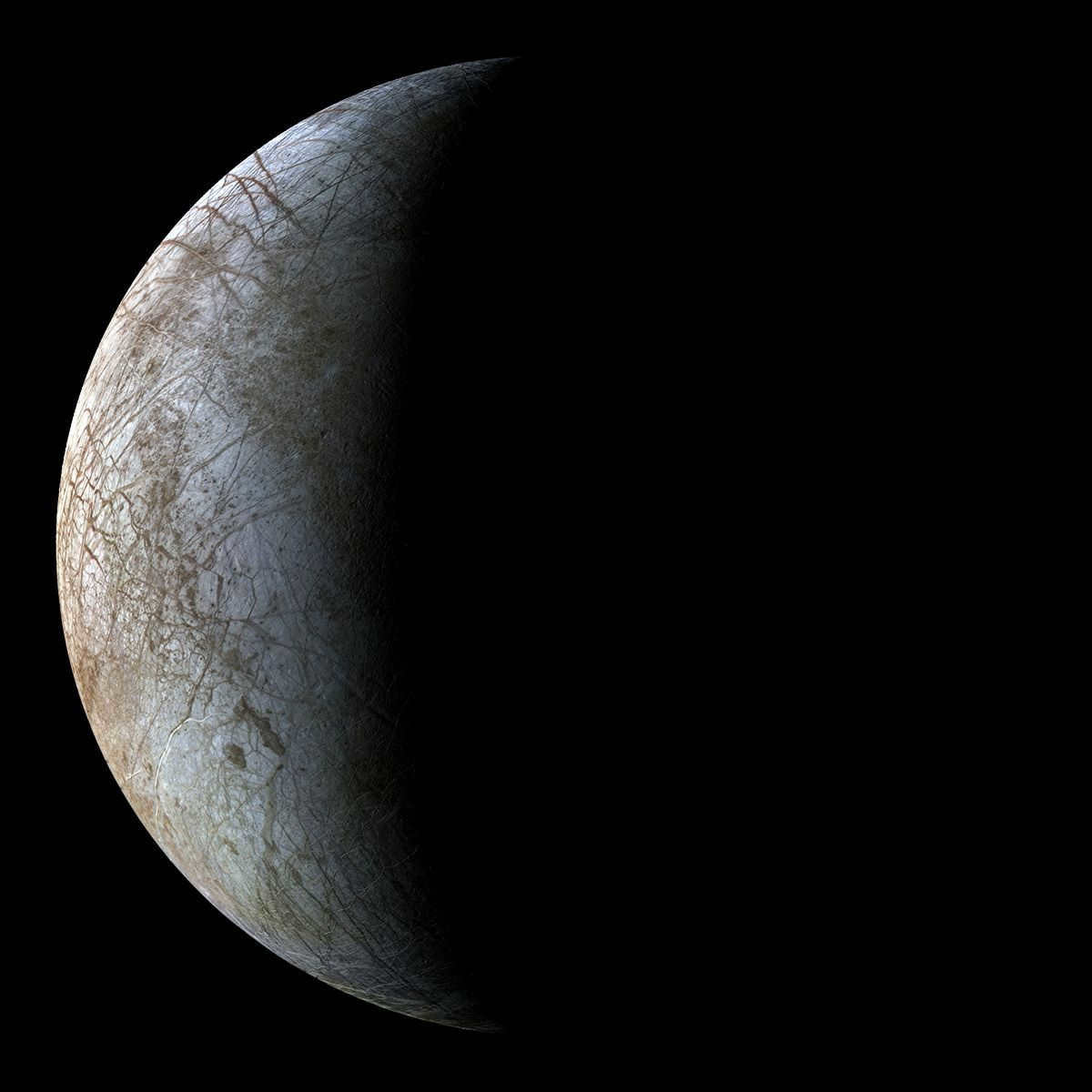
Picture of Europa’s satellite
The surface relief of Europa’s satellite is highly intriguing, and scientists have been studying its origin for many years. It consists of a grid-like pattern of cracks and fractures in the icy outer layer of the satellite. It is believed that the presence of an ocean beneath the ice leads to the formation of warm water that rises from the depths and freezes, causing the ice surface to fracture.
Ganymede
Ganymede is a moon of Jupiter and is the largest moon in the solar system. It was discovered by Galileo Galilei in 1610 and is named after the mythological figure Ganymede, who was a beautiful Trojan prince. Ganymede is the only moon known to have its own magnetic field, which is believed to be generated by a liquid iron core. It is also the only moon known to have a thick atmosphere, composed mostly of oxygen. Ganymede has a rocky surface with a mix of craters, grooves, and ridges. It is thought to have a subsurface ocean of liquid water, making it a potential target for future exploration and the search for extraterrestrial life.
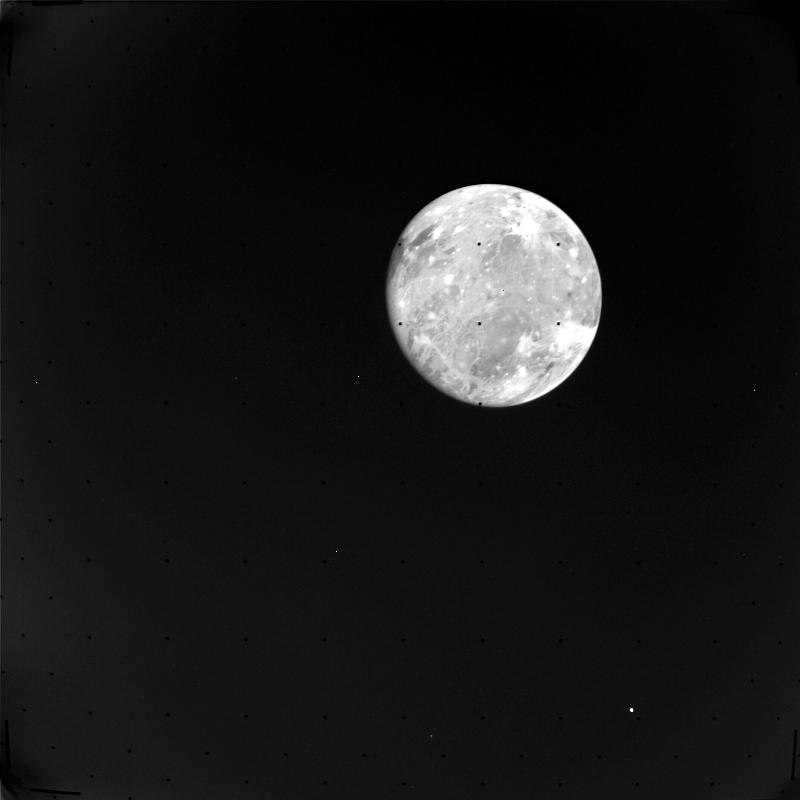
The image above depicts Ganymede, captured by Voyager 1 on March 4, 1979, with visible calibration points.
Ganymede is distinguished from other satellites, not just in relation to Jupiter, but also due to its majestic appearance. It is covered in a thick layer of ice and possesses a robust magnetic field, comparable to that of certain planets. Scientists hypothesize that Ganymede may harbor an ocean similar to Earth’s in its depths, which accounts for the water’s high electrical conductivity. If Ganymede were not a satellite, it could have been classified as another planet.
Callisto
Callisto is one of Jupiter’s moons in our solar system.
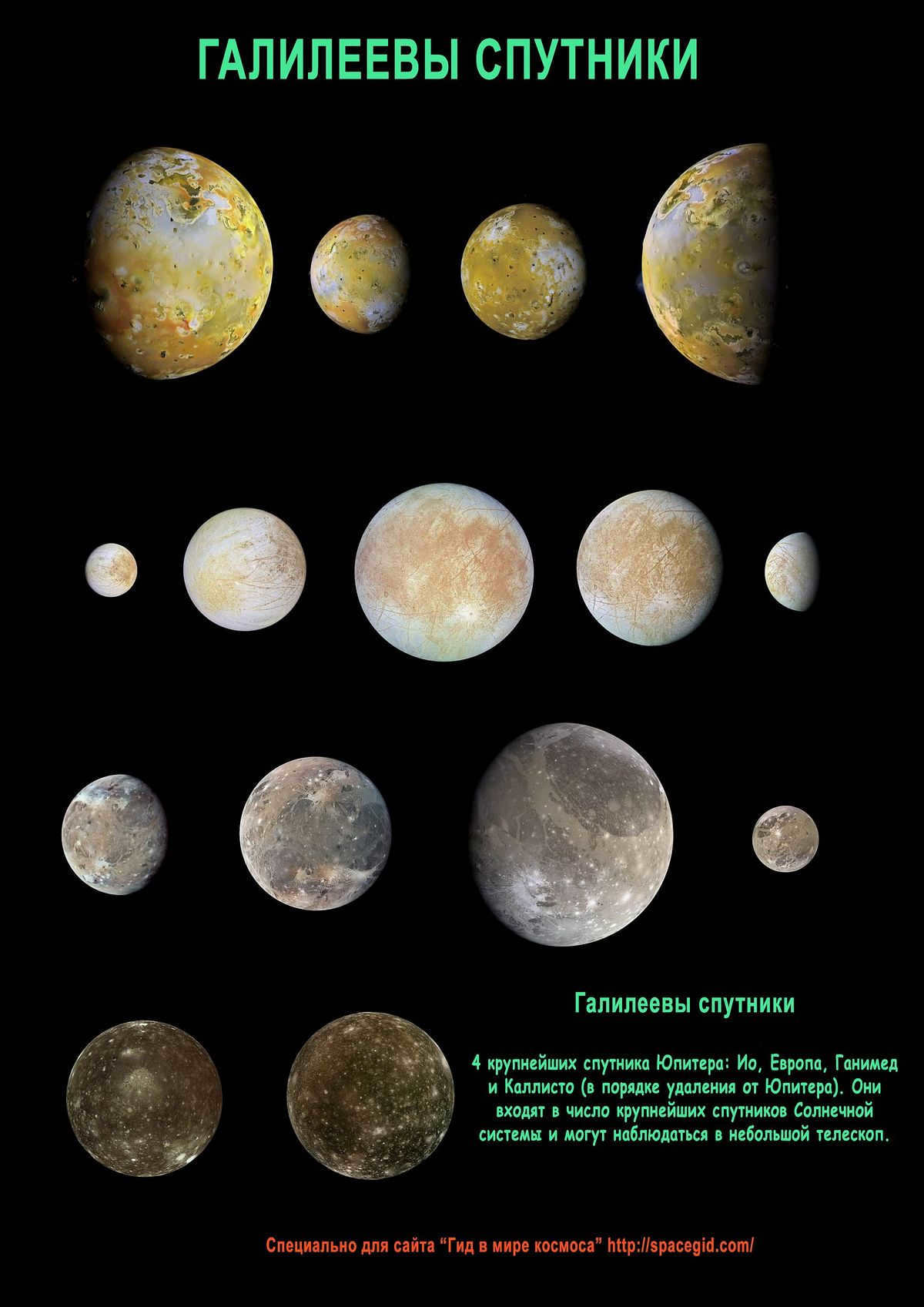
Callisto, unlike any other celestial body, is covered with an extensive amount of craters, which is a testament to its ancient origins and lack of geological activity.
Satellites with Reverse Rotation
These unique satellites orbit Jupiter in a manner that is contrary to the rotation of other satellites, and their orbital positions are slightly inclined towards the planet. Their distant proximity to Jupiter and distinctive characteristics suggest that they were once ordinary asteroids that were captured by Jupiter’s gravitational pull. These satellites are identified by names that end with an “e” – Sinope, Karme, Ananke, and Pasiphae.
This is a brief educational video about the planet Jupiter.
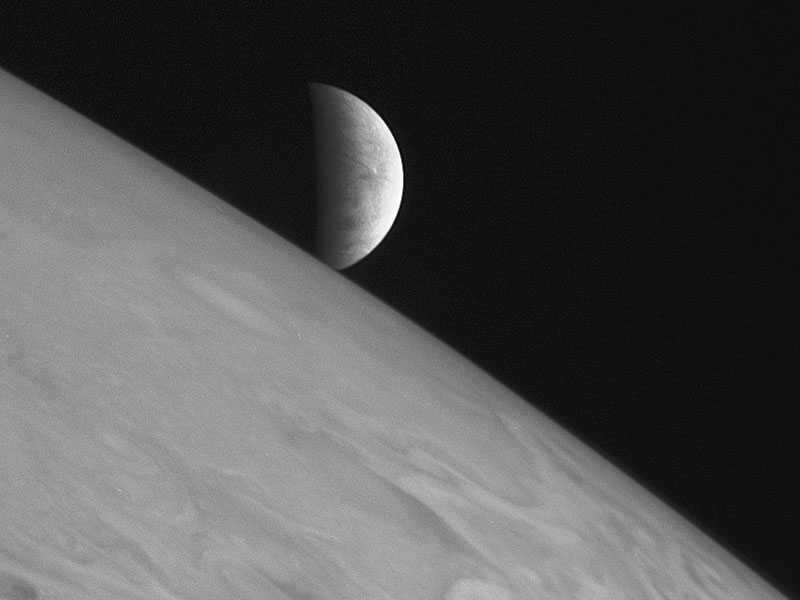
So far, there have been around 180 planetary moons found in our solar system. With the advancements in astronomy and the use of interplanetary spacecraft to explore the cosmos, we are able to detect even smaller celestial bodies, leading to a continuous increase in this number. Jupiter, the largest planet in our solar system, boasts over half of these discovered moons as its own satellites.
Visualization of the movement of Jupiter’s moons
Currently, there are approximately 79 moons orbiting Jupiter, although scientists believe that there could be over a hundred. Out of the known moons, 50 have been given names, which are traditionally female names in honor of Jupiter’s (also known as Zeus) many lovers and daughters. In ancient times, the gods were not known for their morality and discretion, so one of Jupiter’s moons is named Ganymede, after a beautiful young man who caught the mighty thunderer’s eye and was subsequently kidnapped by him. The remaining 29 recently discovered celestial bodies do not yet have official names.
The contribution of Jupiter’s moons to the advancement of astronomy
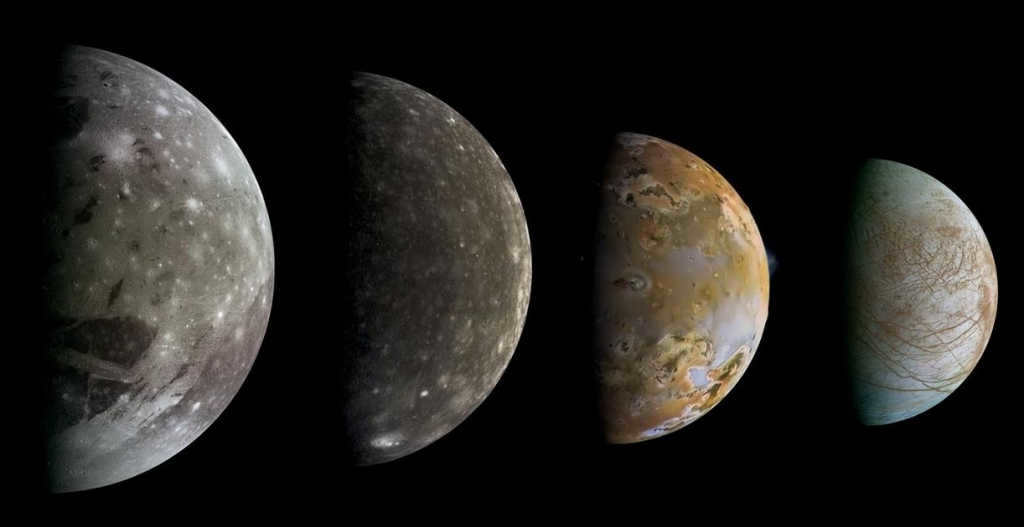
Shown in the image from left to right are Ganymede, Callisto, Io, and Europa. These moons are some of the largest in the entire solar system and can be easily observed using a small telescope.
Jupiter was the first planet in the solar system to have moons, unless you consider Earth’s Moon, which is also a satellite. This discovery was made by Galileo Galilei in 1610 when he used a telescope to observe peculiar stars near the giant planet. After studying their movements for several days, he deduced that they were orbiting Jupiter, indicating that they were not independent planets but rather its satellites. This is how Ganymede, Europa, Io, and Callisto were first identified.
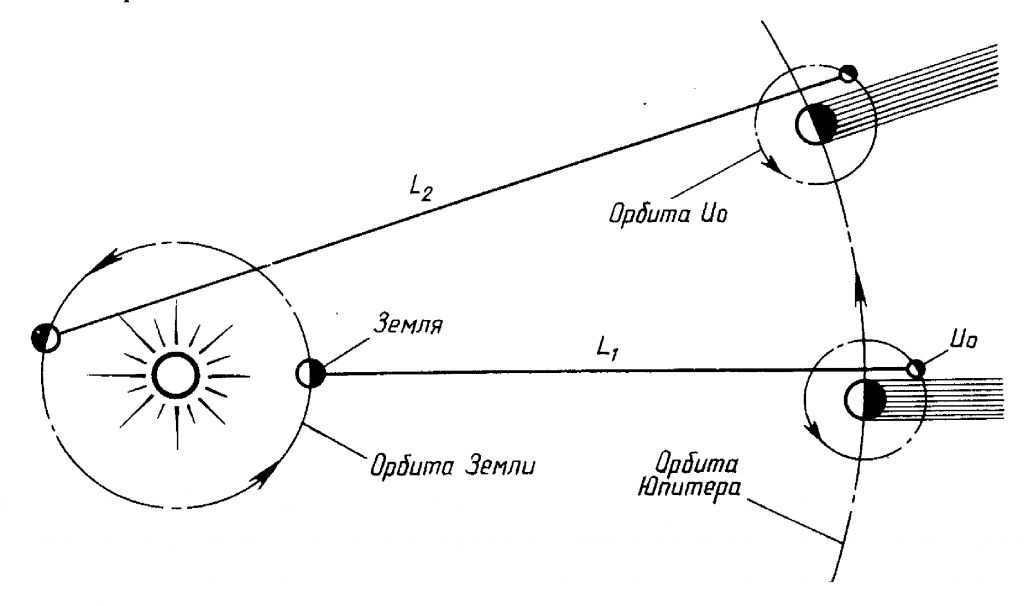
In the 17th century, scientists lacked a precise understanding of the finite nature of the speed of light, thus necessitating experimental investigation into its propagation. Jupiter’s satellites proved to be instrumental in solving this quandary. If light waves from any source propagated instantaneously, the observed location of celestial bodies in the sky would perfectly align with their actual positions. However, if light had a finite speed, the true picture would be distorted due to variations in the distances of the objects in question.
In 1675, Ole Remer, a Danish scientist, conducted calculations to determine the positions of Jupiter’s moons in two different scenarios: one where the Earth and the gas giant are on the same side of the Sun, and another where they are on opposite sides. Upon noticing discrepancies between his calculations and actual observations, Remer correctly deduced that the speed of light is finite. However, due to the limited availability of precise data on the distances between the Earth, Jupiter, and the Sun at that time, he was unable to accurately calculate the exact value of the speed of light.
Star that did not succeed
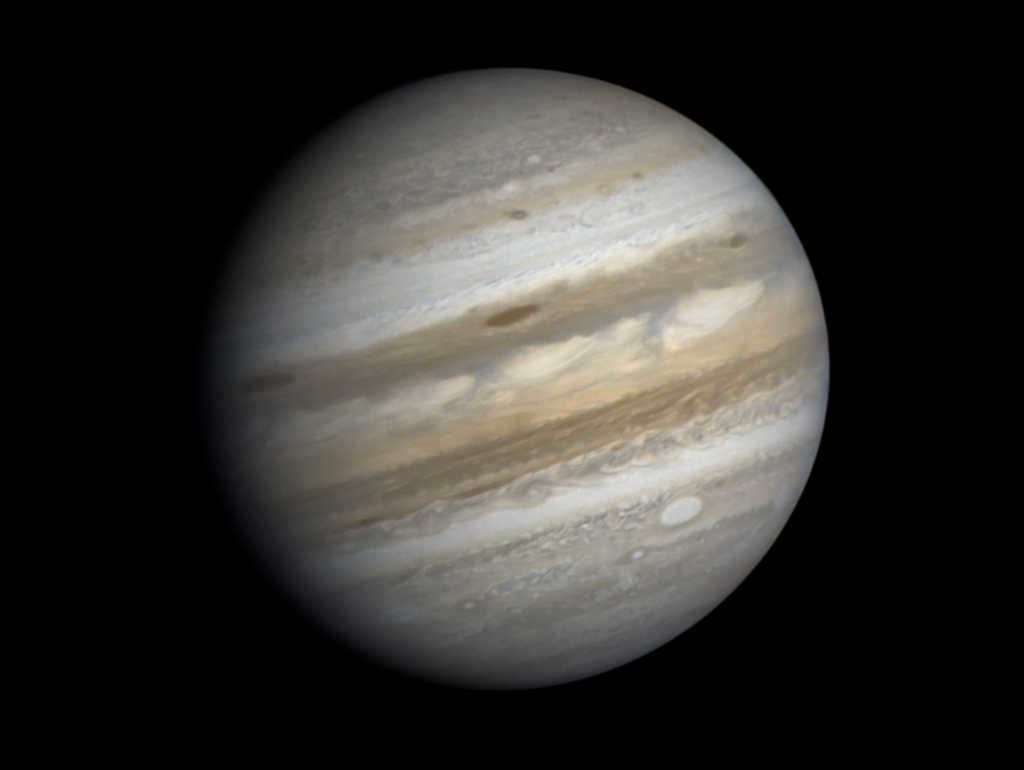
This image of Jupiter has been processed and captured by the Voyager 1 spacecraft.
The power of Jupiter
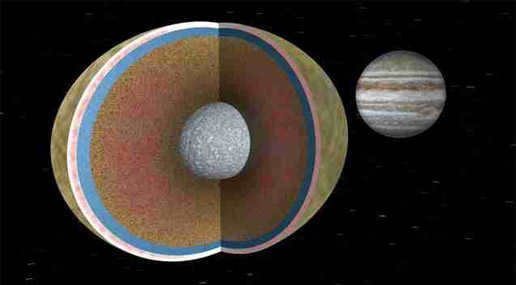
The internal makeup of the planet
Upon investigation of the largest planet within our solar system, it has been discovered that it emits approximately 2.5 times more energy than it receives from external sources. This leads scientists to believe that there are internal sources responsible for this phenomenon. Furthermore, Jupiter’s radiation spans a broad range of wavelengths, encompassing even the visible spectrum.
Despite extensive research, a universally accepted explanation for this occurrence has yet to be determined. It is theorized that the energy sources could potentially arise from the phase transition processes of metallic hydrogen in its molecular phase. Additionally, many experts concur that the planet’s core is heated through internal compression, resulting in temperatures ranging from 20,000 ° C to 30,000 ° C, depending on the source.
Jupiter’s satellites classification
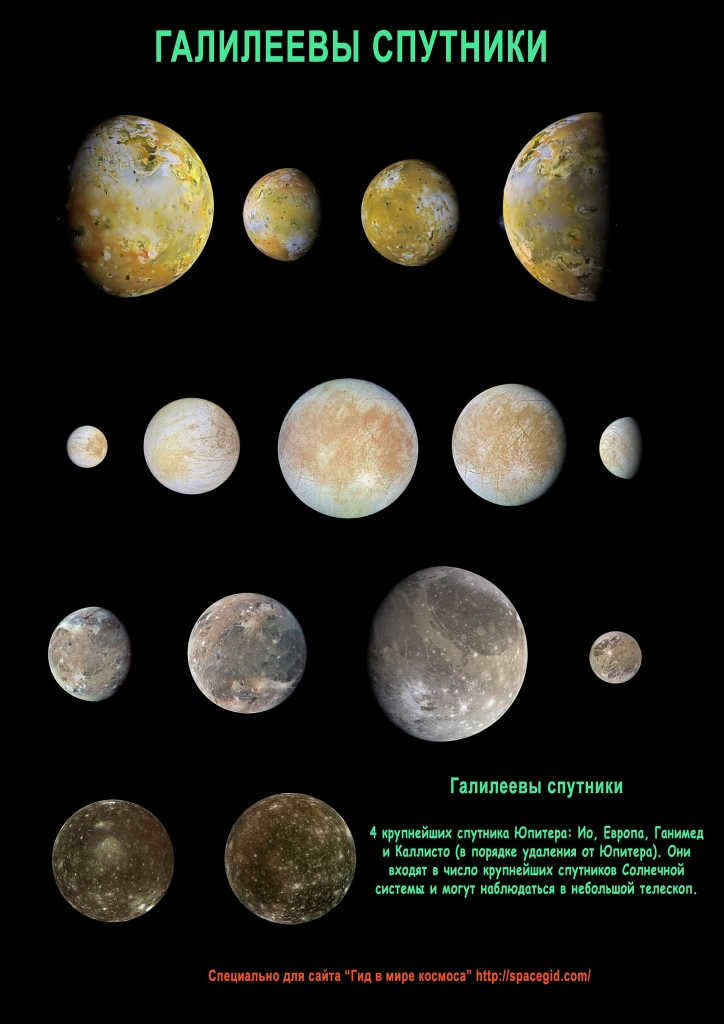
If a planet has numerous satellites, they are typically categorized into three main groups for convenience: primary, internal, and external. The primary satellites refer to the largest satellites, and in the case of Jupiter, it includes Ganymede, Europa, Io, and Callisto. These satellites are often referred to as the “Galilean” satellites, named after the Italian scientist-astronomer who discovered them. The space surrounding the central planet is divided into inner and outer regions based on the orbits of the primary satellites. Depending on the location within these regions, other satellites are classified as “inner” or “outer”.
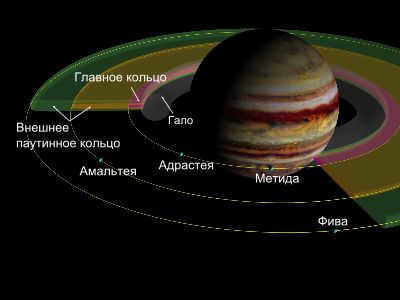
The inner satellites of Jupiter are considerably smaller compared to the Galilean satellites and have orbits that are very close to the planet’s surface, ranging from 1.8 to 3.1 times the radius of Jupiter.
The main satellites, on the other hand, are situated at a slightly greater distance, forming a ring approximately 20 times the radius of the planet. The closest of these satellites, Io, is located six radii away from the center of rotation. Both the inner and main celestial bodies that comprise Jupiter’s collection of satellites orbit within the planet’s equatorial plane.
The outer moons are positioned at a range of 2-50 million km from the planet’s core. Their sizes in volume are approximated to be a few kilometers, although there are a handful of comparatively sizable ones (the largest being 170 km). These celestial objects typically exhibit an asymmetrical form, elliptical paths, and diverse angles in relation to the planet’s equatorial plane.

There are certain satellites that revolve in the opposite direction compared to the planet’s rotation and other satellites. The gravitational pull of any object can be measured by determining its gravitational sphere of influence (known as the Hill sphere), which for Jupiter is approximately 50 million kilometers. This boundary serves as a potential area to explore for additional satellites.
Moons within a celestial body
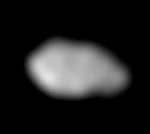
Jupiter possesses four inner satellites, all situated within the orbit of Io, the nearest Galilean satellite to the planet.
These are named Adrastea, Amalthea, Metida, and Thebes. The most sizable among them – Amalthea – boasts an irregular form, extensively punctuated with craters, and it ranks fifth in Jupiter’s system in terms of size (270x165x150 km). Phoebe, approximately half the size (116x98x84 km), exhibits an ellipsoidal shape. The remaining two satellites, Adrastea and Metida, measure 25x20x15 km and 60x40x34 km, respectively.
All four minor planets fall into the category of regular satellites, meaning they orbit in the same direction as the primary satellites and their orbits lie in the equatorial plane, close to being circular.
Amalthea is a small moon of Jupiter.
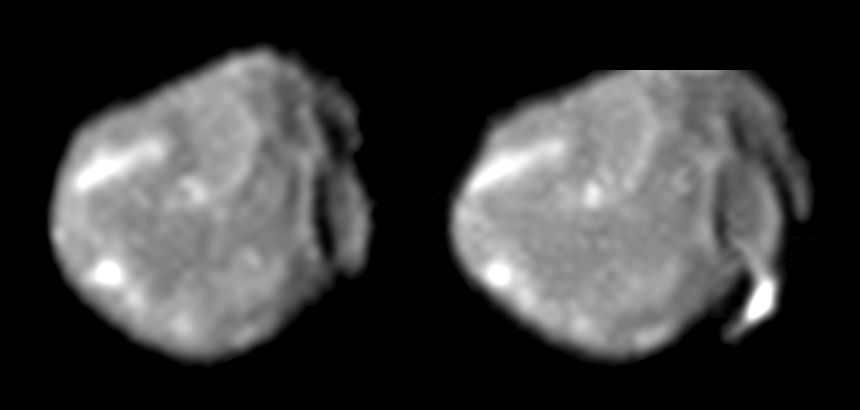
Amalthea, photographed by the Galileo probe
Among the satellites mentioned above, Amalthea is particularly fascinating. It was discovered in 1892 by Edward Barnard and stands out with its unique dark red surface, unlike anything else in the solar system. Recent studies indicate that Amalthea is primarily composed of ice, with traces of minerals and sulfur-containing substances.
These findings explain the low density of the celestial body (900 kg/m3) and are supported by radiation analysis. However, the origin of its distinct color remains a mystery. Based on this hypothesis, it is possible to speculate that Amalthea might have originated outside of Jupiter, as it is unlikely for an icy satellite to form so close to the planet’s surface.
Exterior Moons
The exterior moons, of which there are currently 59, possess a much broader range of parameters and characteristics compared to the primary and interior moons. All of these moons follow elliptical orbits with a significant inclination angle to Jupiter’s equatorial plane. When observed by passing spacecraft, the exterior moons appear as amorphous blocks with surfaces eroded by cosmic wanderings.
These moons can be categorized based on their values for the large semi-major axis and the angle of rotation inclination with respect to Jupiter’s equatorial plane, as well as their direction of orbit. Some of these moons occupy very close orbits and likely represent fragments of a larger celestial body that was shattered due to a collision with another object in space. Closer to the planet, there are moons that orbit in the same direction as the primary moons.
Irregular moons
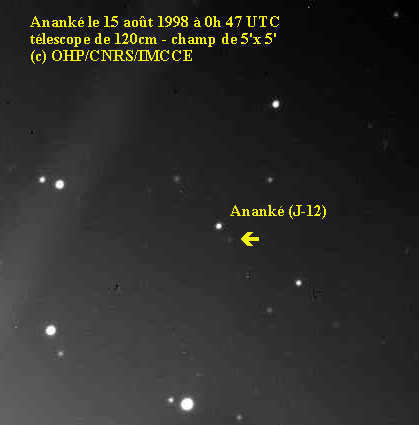
Following are the satellites that have opposite motion. They are divided into clusters: Ananke, Karme, Himalia, and Pasiphae. Each of these families consists of one big (larger than 14 km in size) and several small (less than 4 km) objects.
The resemblance of their paths probably suggests the shared origin of satellites within the same cluster, which is further supported by analyzing their speeds, which are not significantly different from each other. Some satellites are still unclassified and are awaiting further study.
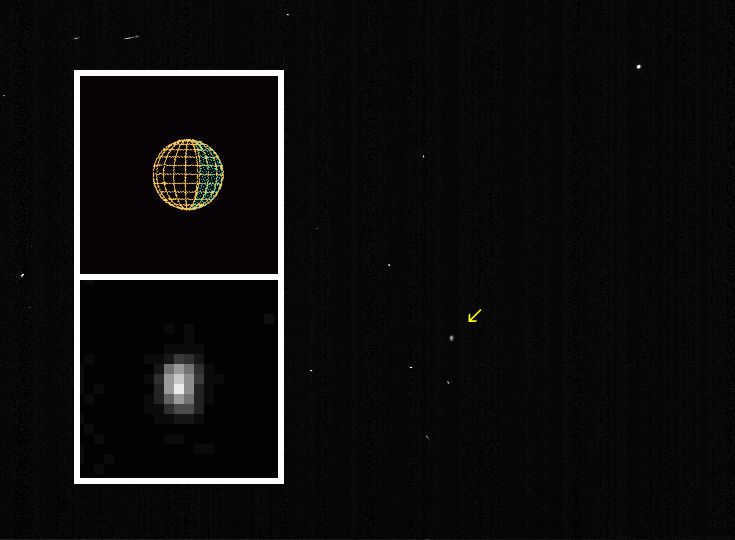
The exploration of celestial objects in the outer orbits of Jupiter is fascinating due to their minimal changes since their formation, which provides valuable information about the nature of our solar system.
It is highly likely that some of these objects originated from other regions of the galaxy and were subsequently captured by Jupiter’s gravitational pull. By analyzing their chemical composition, we can gain insights not only about Jupiter and its satellites, but also about the overall structure of the Universe.
Primary (Galilean) moons
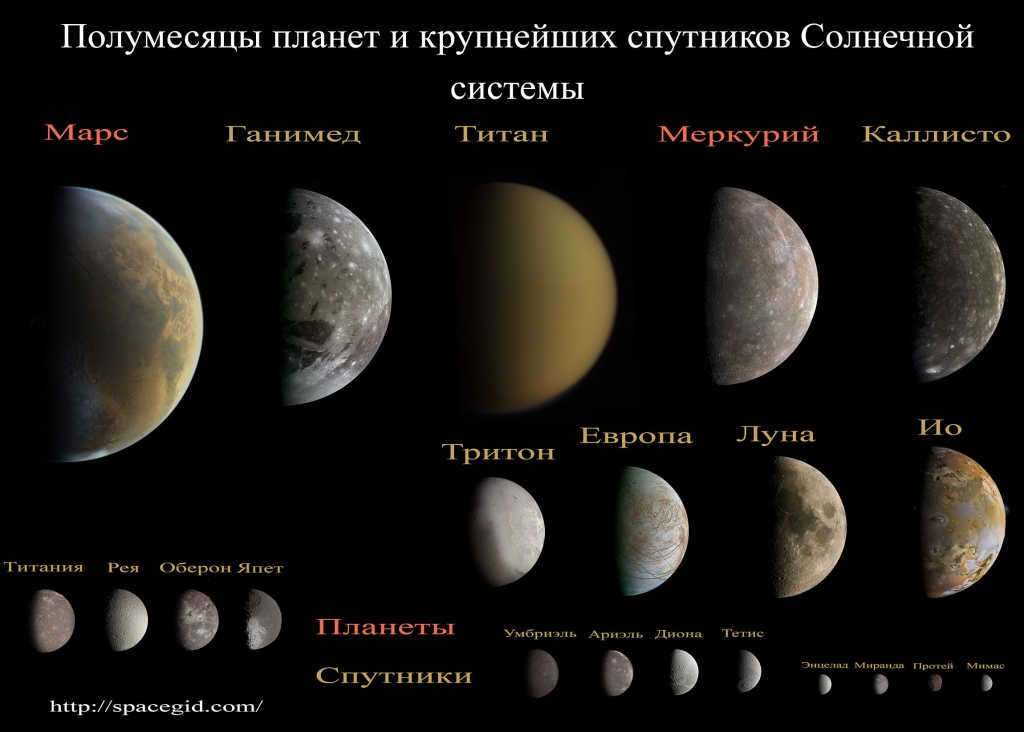
The celestial bodies that revolve around the gas giant Jupiter are known as the major satellites. These satellites were formed simultaneously with Jupiter and have orbits that are nearly circular. They rotate in the same plane as Jupiter’s equator and are located at distances ranging from 420,000 km to almost 2 million km from the planet’s core. There are four major satellites in the Jupiter system, namely Io, Europa, Ganymede, and Callisto. These satellites have varying densities depending on their distance from Jupiter. The closer a satellite is to Jupiter, the denser its material. For example, Io has a density of 3530 kg/m3, while Callisto has a density of 1830 kg/m3. Similar to the Moon’s relationship with Earth, these celestial bodies always face their respective planet on one side.
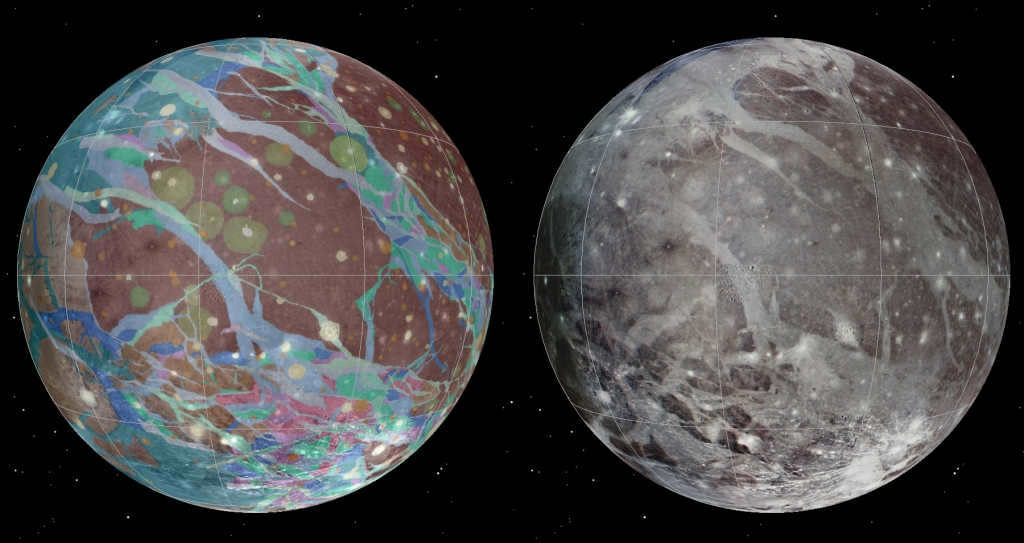
The initial geologic map of Ganymede
All of Jupiter’s moons are at least 1.5 times larger than the Moon, and Ganymede, the largest moon in the Solar System, is 8% larger in diameter than the smallest planet, Mercury. However, due to its low density (1936 kg/m3;), it has less mass than Mercury by more than twice. Scientists theorize that there were originally more moons, all formed from a single gas and dust cloud. Eventually, some of them were pulled by Jupiter’s gravitational forces and fell onto its surface, leaving only the four moons that we observe today.
Unique characteristics of the Galilean moons
Extensive research conducted by astronomers from various nations, along with valuable data collected from multiple interplanetary space missions, have provided a wealth of fascinating information about the primary moons orbiting Jupiter.
Io
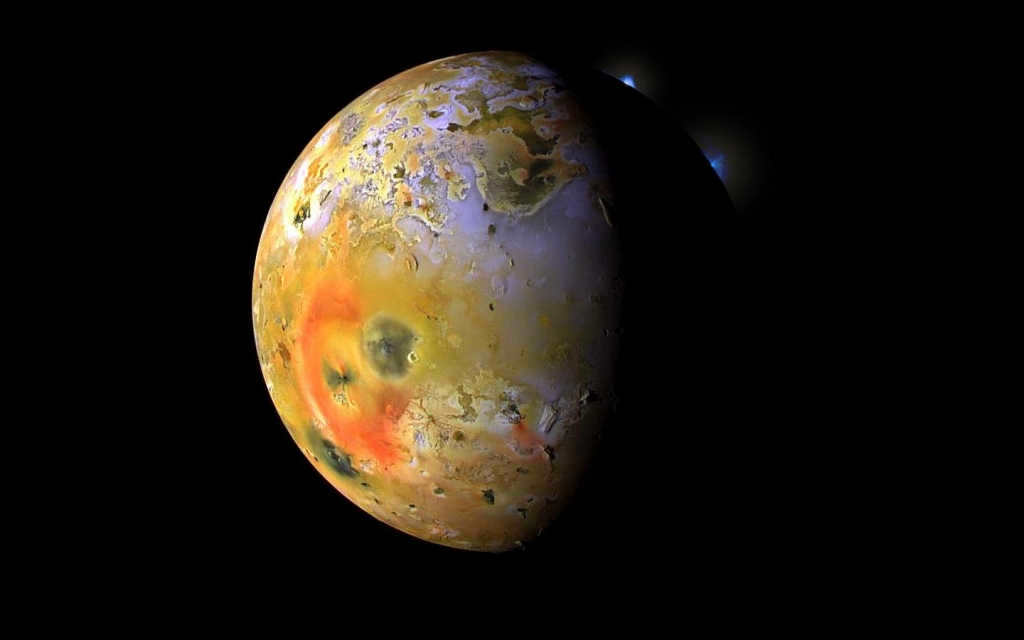
The celestial body known as Io is renowned for its high level of volcanic activity, making it a unique entity within our solar system. The close proximity to the massive planet Jupiter has resulted in the satellite’s surface experiencing significant fractures and emitting sulfur, which gives it a distinct orange-yellow hue. It is believed that Io’s surface is primarily composed of a combination of ice and rock.
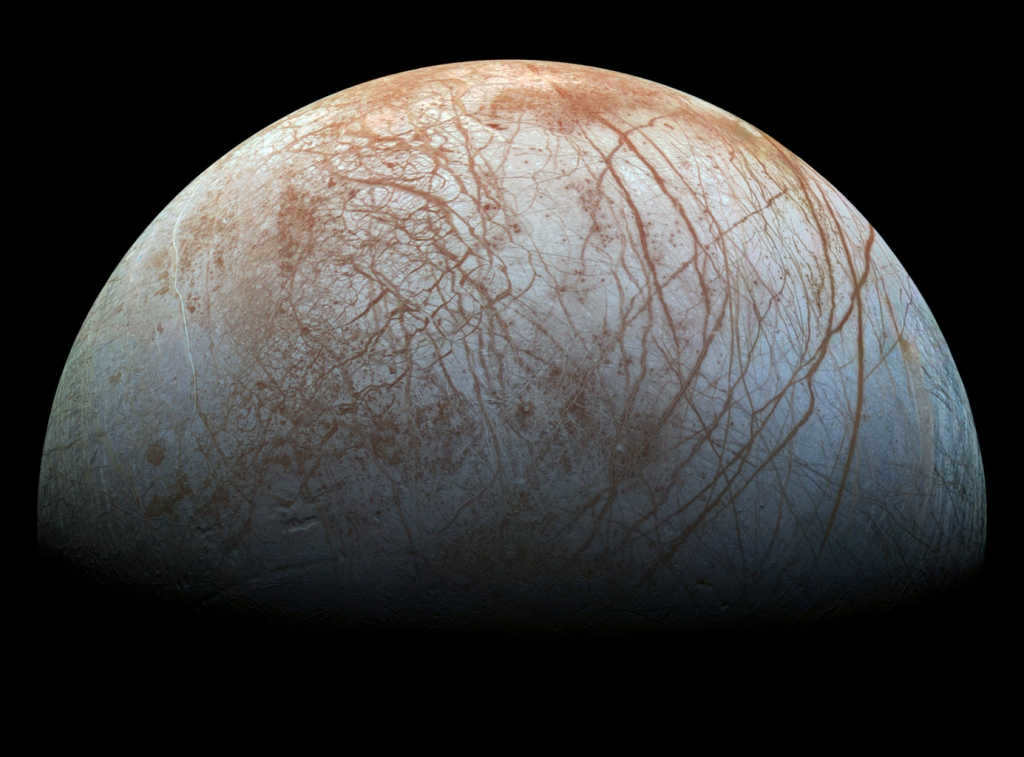
Europa, an image taken by Galileo
Europa is completely covered by a layer of ice, beneath which there may be a liquid ocean that holds more than twice the amount of water found on Earth. This leads to speculation about the possibility of life existing on Jupiter’s moons. The surface of Europa, as seen in the photographs, displays a network-like structure, indicating the presence of faults, cracks, and protalines. It is also believed that Ganymede and Callisto have water. The amount of water on Europa could be twice that of Earth. Additionally, it is believed that the planet’s gravitational forces generate internal heat, keeping the planet warm.
Ganymede is a moon of Jupiter.
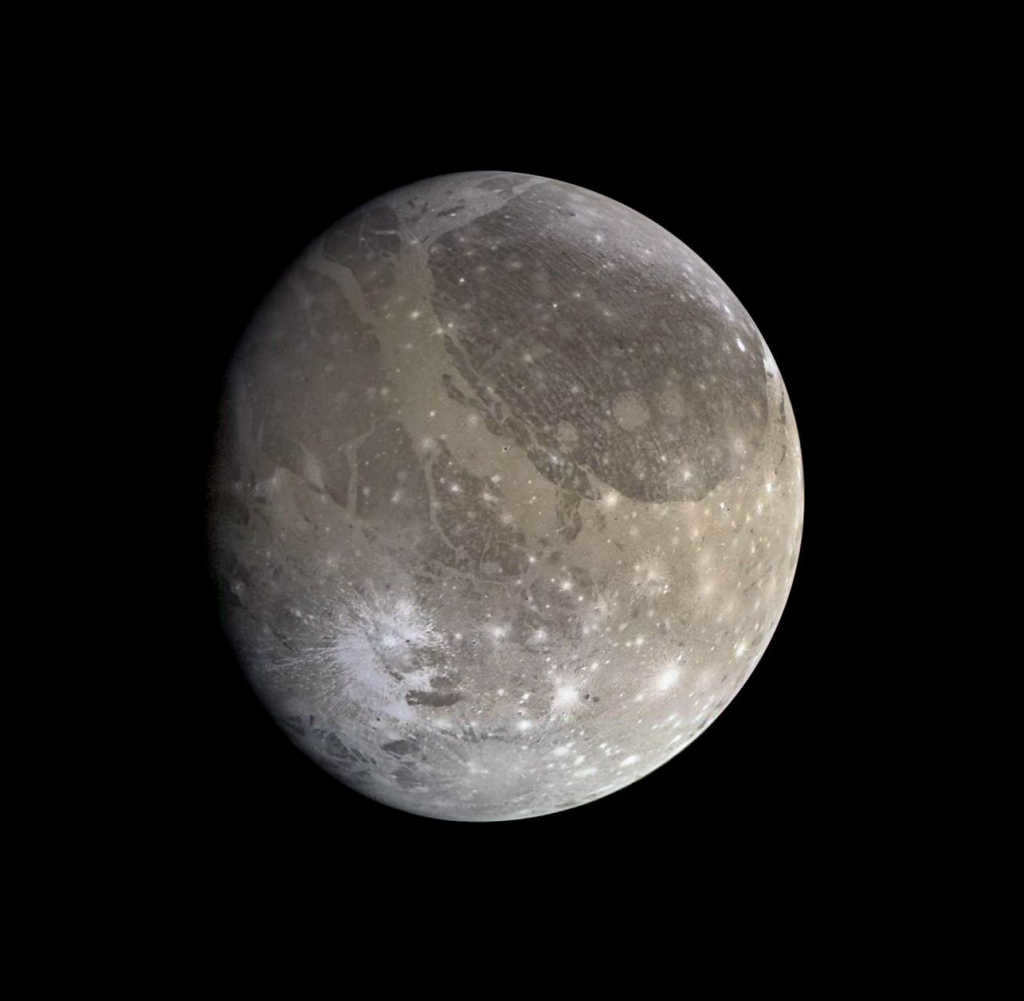
Ganymede, which is bigger than the planet Mercury, holds the title of being the largest satellite in the solar system. What makes Ganymede unique is that it possesses its own magnetic field.
Callisto
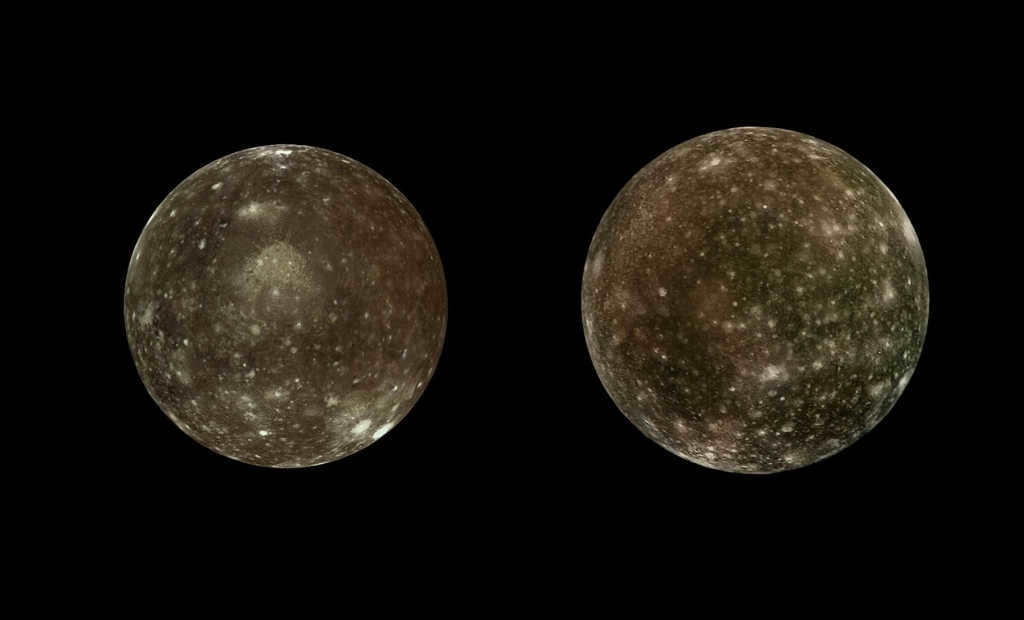
Callisto, the fourth moon, possesses one of the highest concentrations of impact craters on its surface. Unlike the other moons, Callisto’s terrain is remarkably ancient, featuring billions of years worth of impact craters.





